
Nothing Like a Flash Flood to Keep Things Interesting

Blog 22 by Tan: Nothing Like a Flash Flood to Keep Things Interesting
We were informed by the guy at the Skeleton Coast gates that the 4×4 route that hugs the southern border of the national park was the most scenic route inland. He had worked in the park for more than 20 years so we figured he knew what he was on about. Instantly we were met with one of the most eerily scenic and fun remote routes of the trip so far.
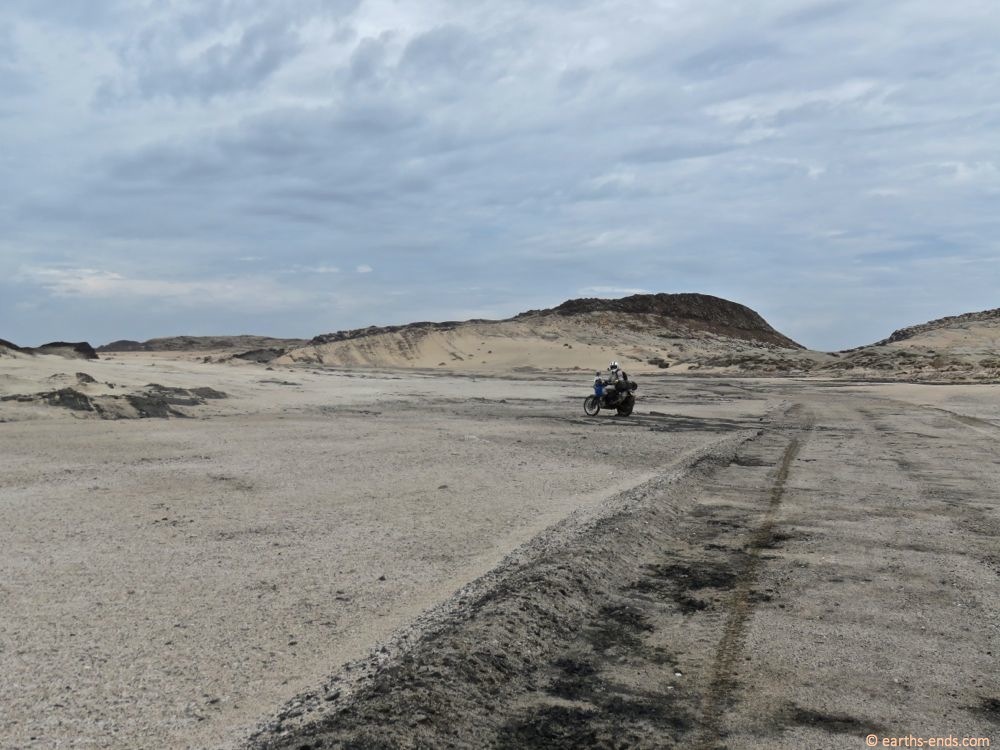
Mick skirting the edges of the Skeleton Coast park
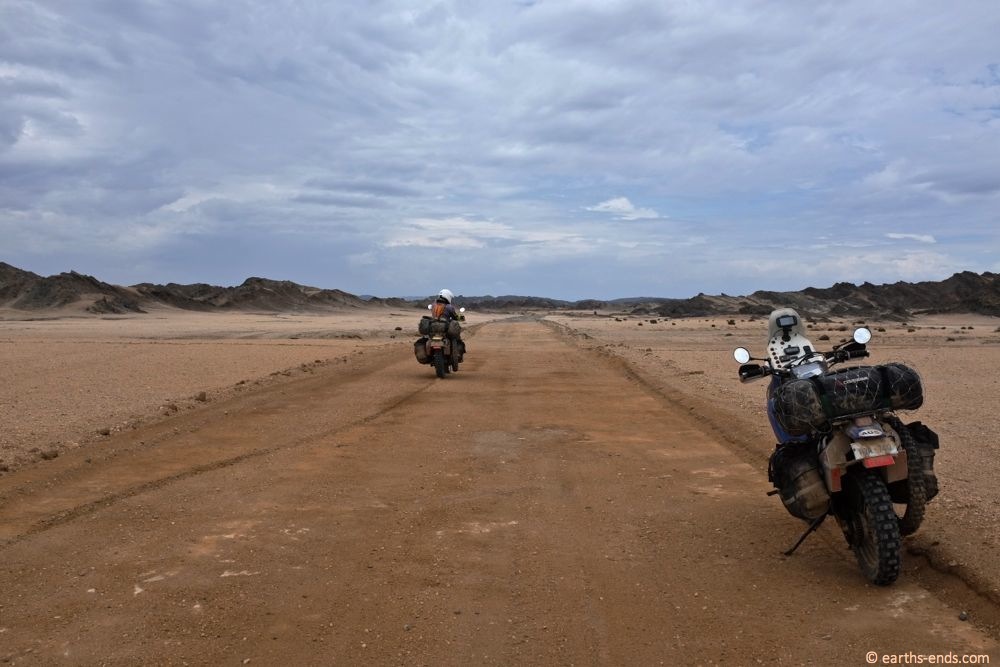
A typical Namibian desert road
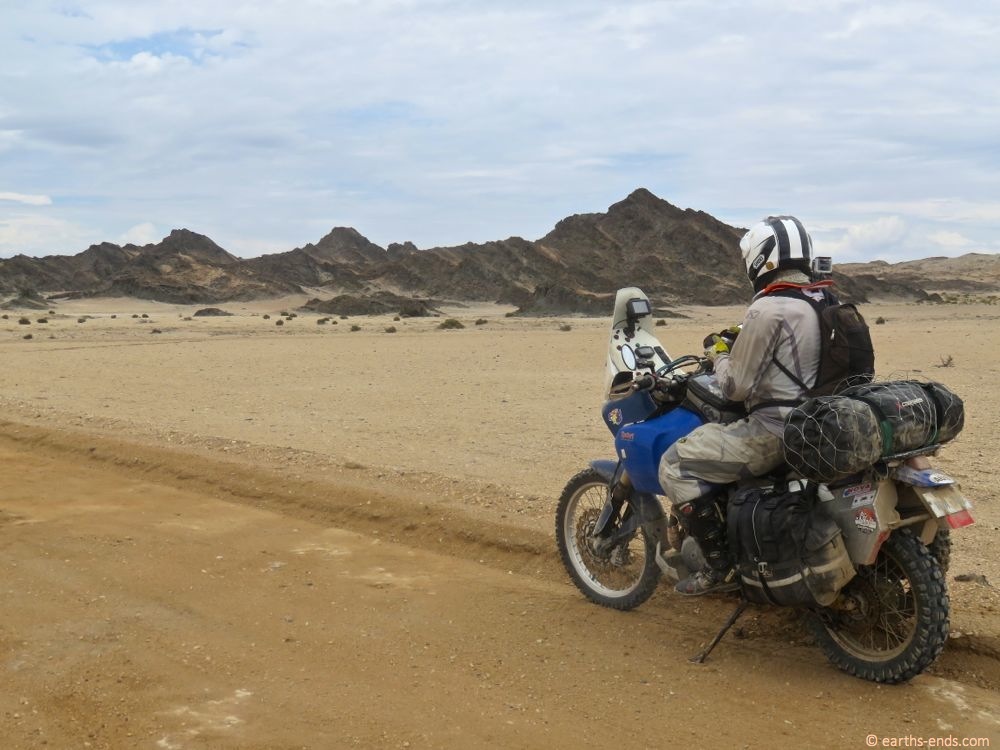
Mick pondering the change in landscape
As we rode east through the flat, sandy expanse, relict sand dunes were replaced by tilted strata showing awesome bedding and a range of other cool stuff I would have loved to have gotten a closer look at were we not enjoying the ride so much. The road itself was in good condition and belied the 40km an hour speed limit applied to it. In Namibia, many of the roads are gravel but they tend to be in good condition through diligent maintenance but probably more due to the naturally dry conditions.
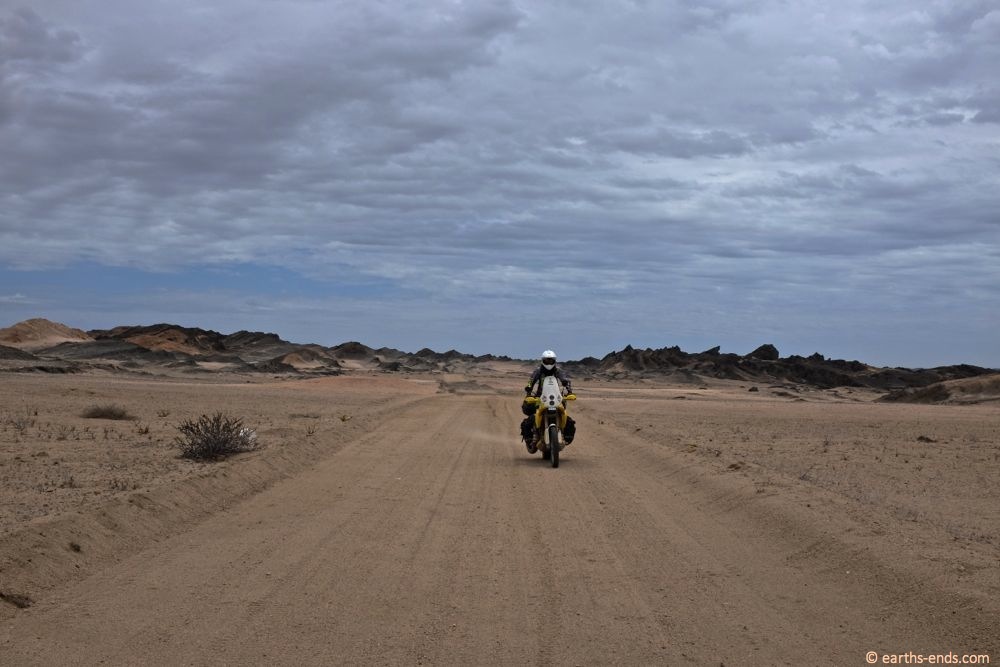
A beautiful if eerie landscape

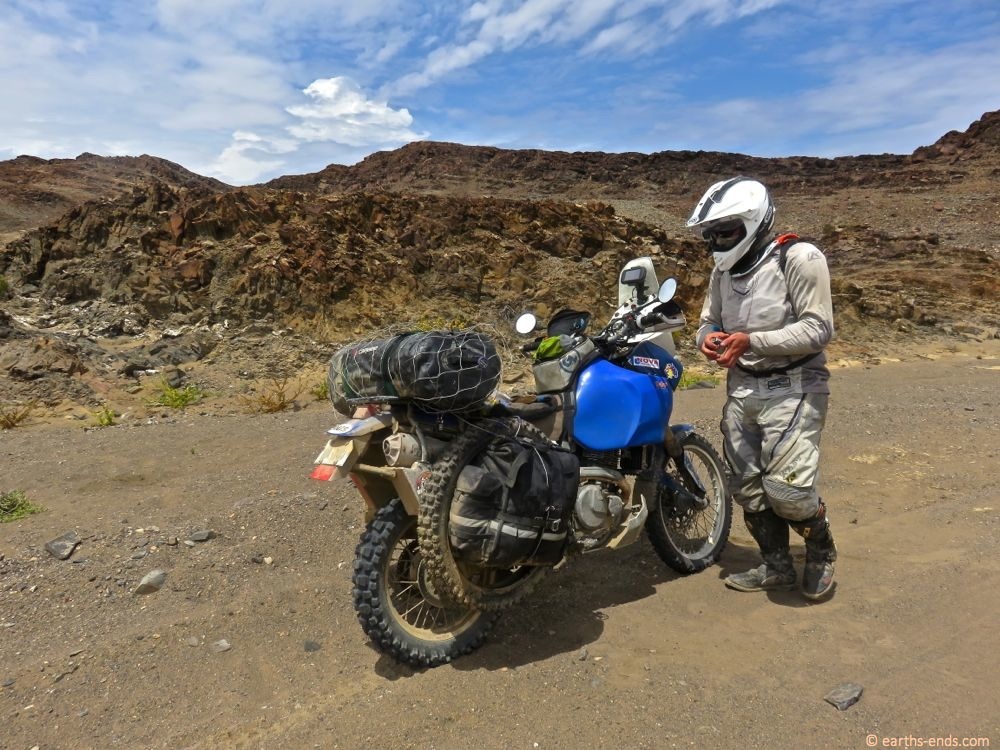
We’re pretty happy with our luggage system. The amount we carry allows us to be comfortable and pretty well self sufficient but still able to go just about anywhere.
Sand gave way to gravel as we approached Brandberg and the only colour that broke up the beautiful yet monotonously brown landscape was the green sprawling leaves of the Welwitschia plant, which tenaciously clings to life in the harshest of conditions and for centuries at that. The big ones are said to be up to two thousand years old. It is hard to imagine any water ever having touched this place yet things survive. We saw groups of springbok running around and we couldn’t help but think “What are you doing here? How the hell do you survive here? Don’t tell me you live on horse shit too?”
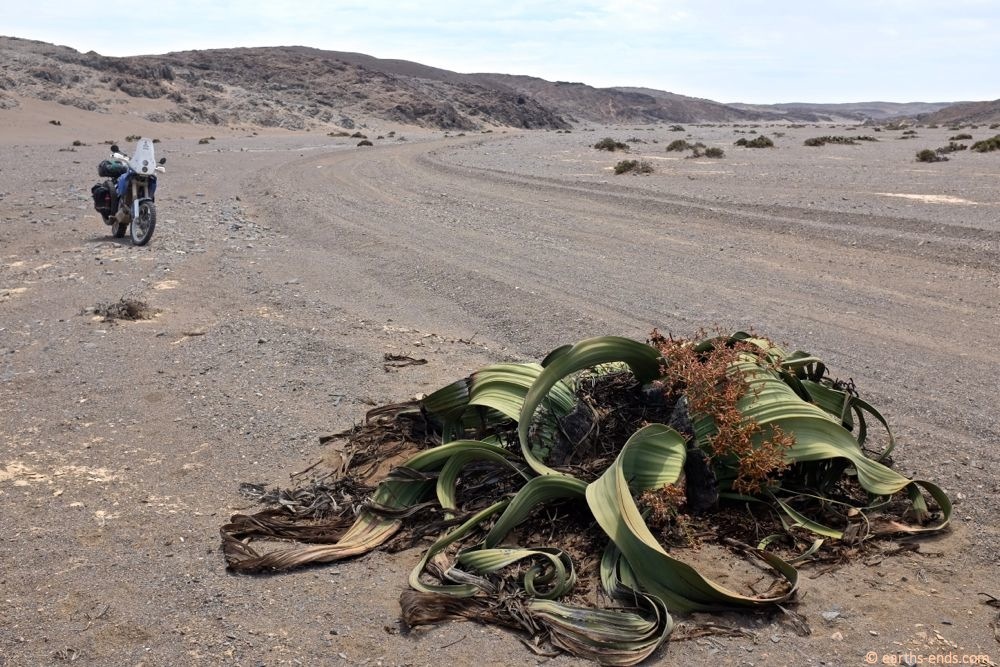
The Welwitschia plant is known as the ‘living fossil’. 2000 years old is not a bad innings at all.
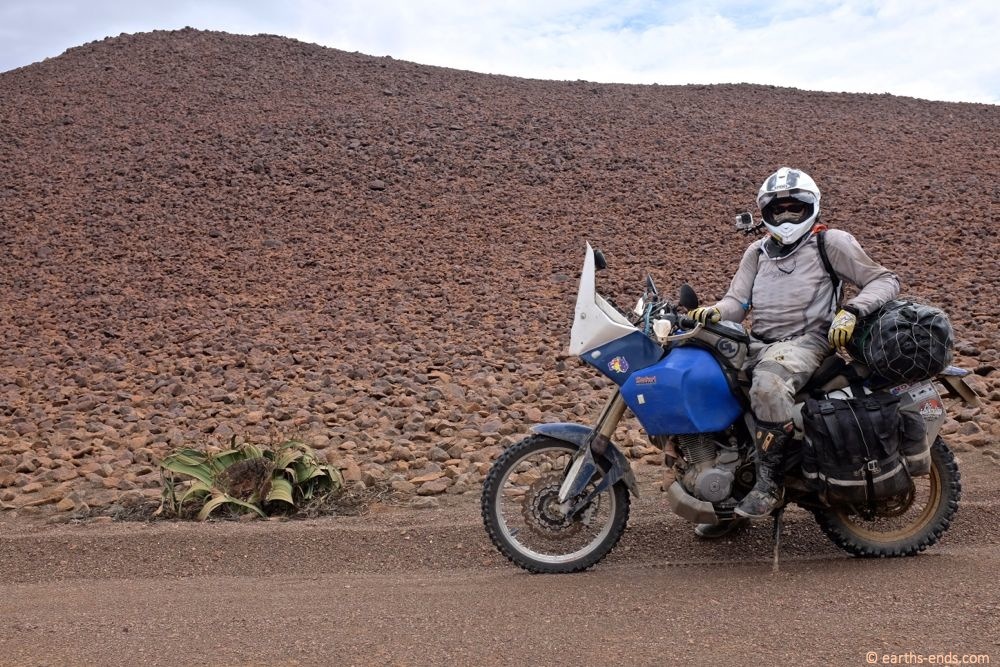
A beautiful but inhospitable place
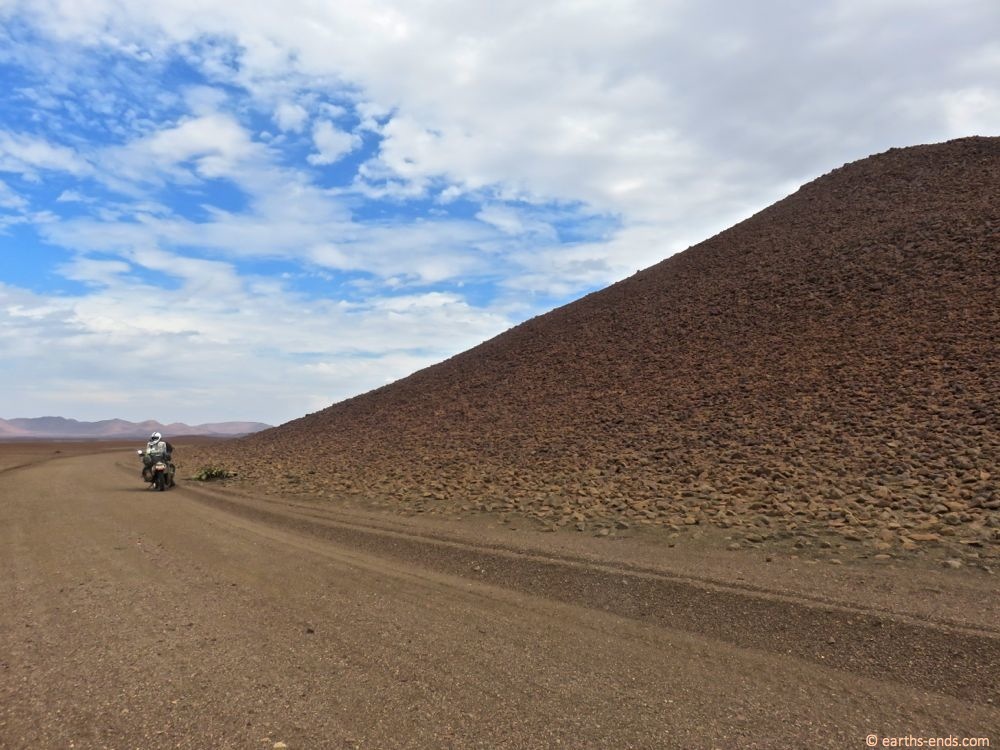
See what I mean?
Soon enough the landscape changed again and we got our first glimpses of the famed folded mountains of the Ugab River. As we rode closer to the Ugab river valley, rocks replaced gravel and we braced ourselves for the dreaded pinch flats that fortunately never came despite the harshness of the trail.
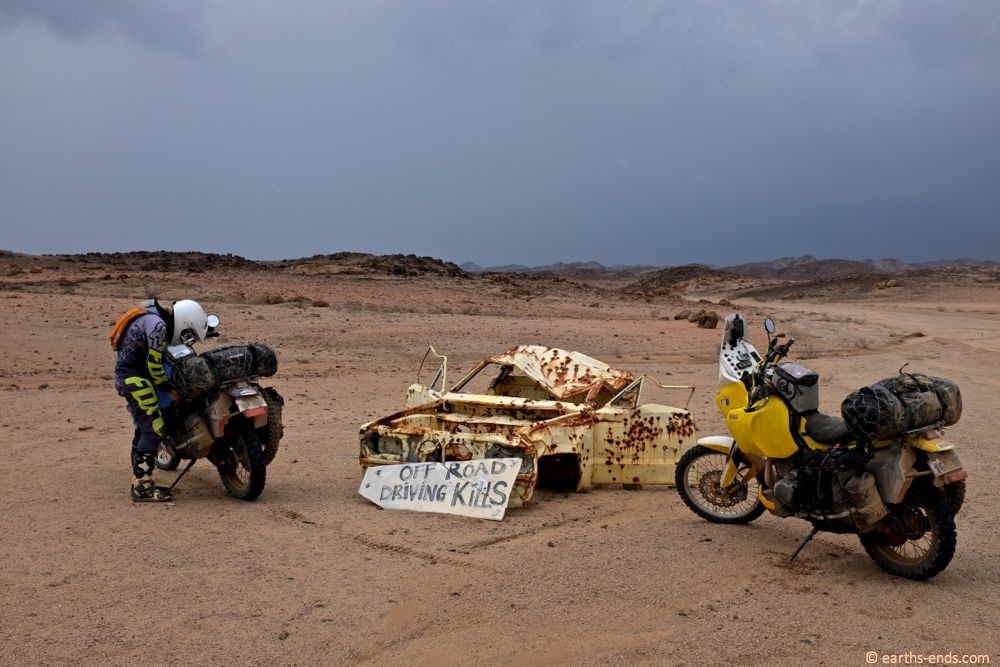
Ominous clouds so into the wet weather gear

Mountains – folded ones

Another terrain change
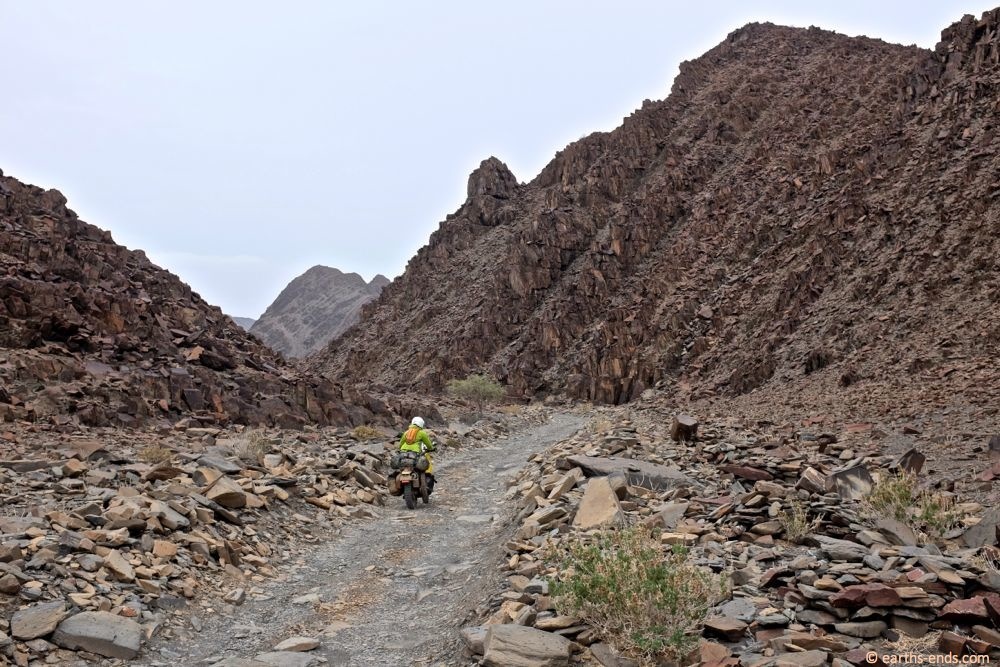
Rocky much?
Upon arriving at the remote and deserted Brandberg West Rhino Camp our GPS showed two trails to Twyfelfontein, our next destination. We passed a Swiss couple in a Landrover (first car for the day) who said they had amazing views through the river valley. We started along what we thought was the right trail before doubling back when it turned north out of the riverbed. Not wanting to miss the amazing scenery, we found a trail heading down the river valley proper with what looked like fresh tracks so figured this must have been the way the Swiss had come. And as a bonus the GPS informed us this way was slightly shorter. So we went for it, and were soon greeted with deep river sand.
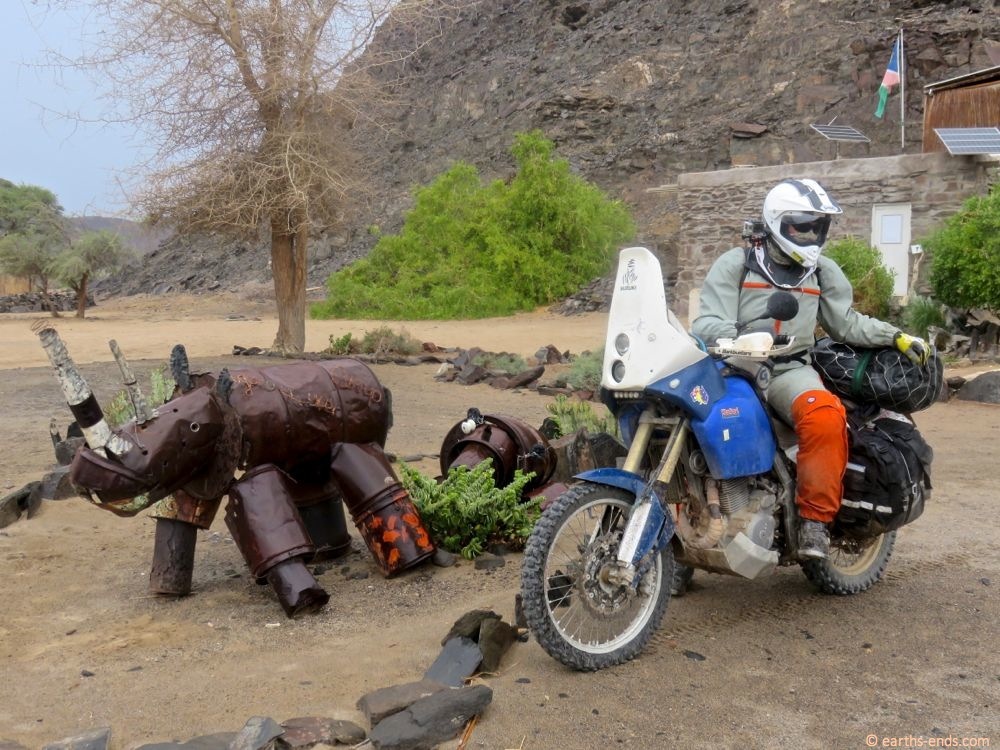
Mick taking a breather at Rhino Camp
It was challenging but good fun. However, it wasn’t long before the sand became really serious. For me it was some of the hardest sand we’ve ridden as the grains of sand were so coarse and so well rounded that they seemed to roll underneath the tyres like tiny little marbles. As we continued we came across sections of waterlogged sand which made the bikes work like crazy. There was no respite whatsoever, it was standing up all the way, leaning back and powering through. It was so physically taxing, to turn in the stuff you weren’t merely leaning on the pegs but having to throw your full body weight around to get the necessary traction.
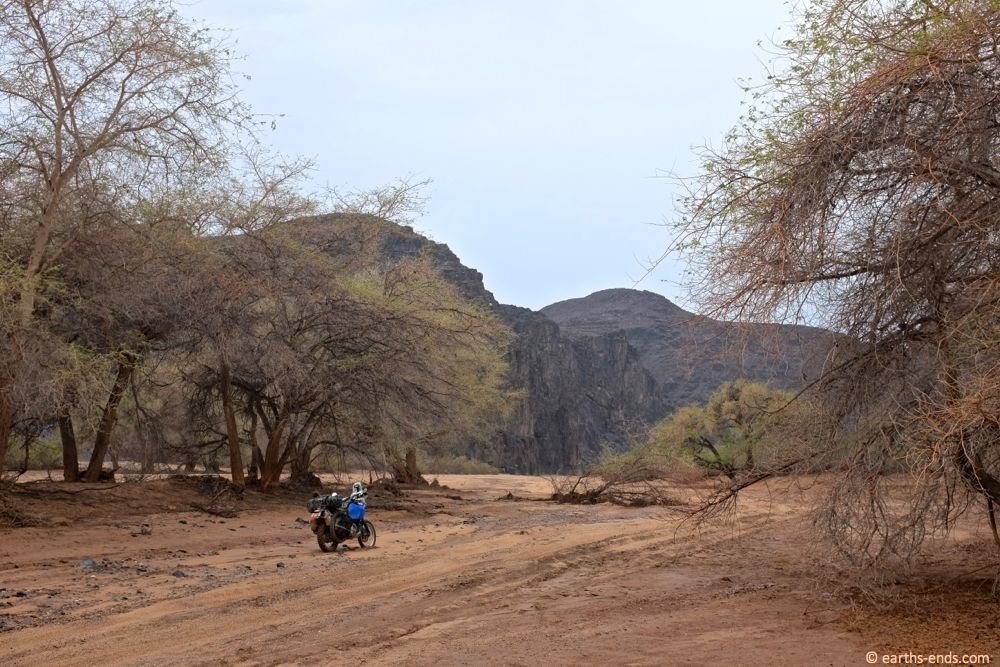
The start of the diabolical sand…. I know it doesn’t look like tough sand but it was
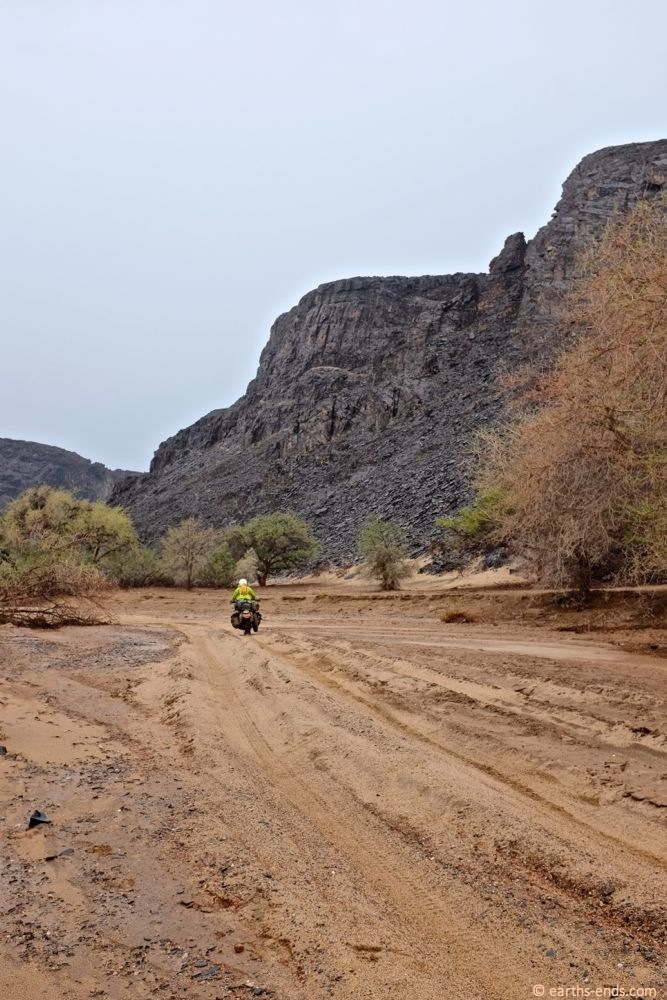
Sand riding – love to hate it – hate to love it
The hard physical riding combined with the high temperate and high humidity left me sweating like a gypsy with a mortgage, as the honeybadger would say. I found this rather strange as it is not typical to work up such a sweat through uninterrupted riding. We hadn’t stopped to pick up a dropped bike or to dig one out of the sand. The bikes were working just as hard though, we stopped every 20 minutes or so to cool them down a bit when our warning light indicated over 140 degC. Due to the amount of sharp rocks around we decided to keep the bikes at gravel road pressures; 20psi front and 25psi rear. While far from easy it was fantastic forced upskilling in sand riding.
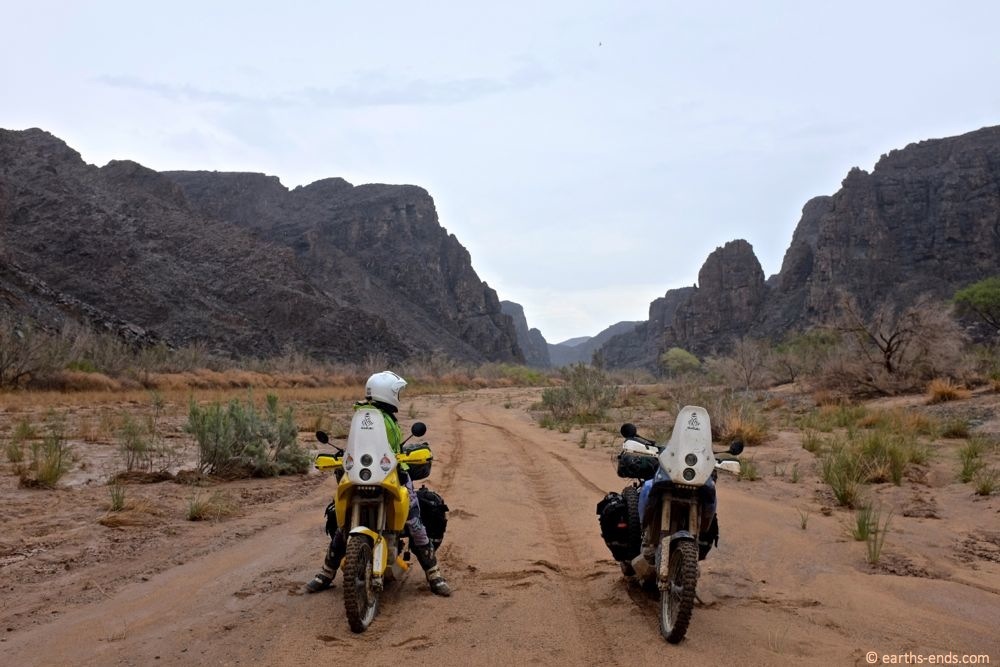
Fantastic views all around
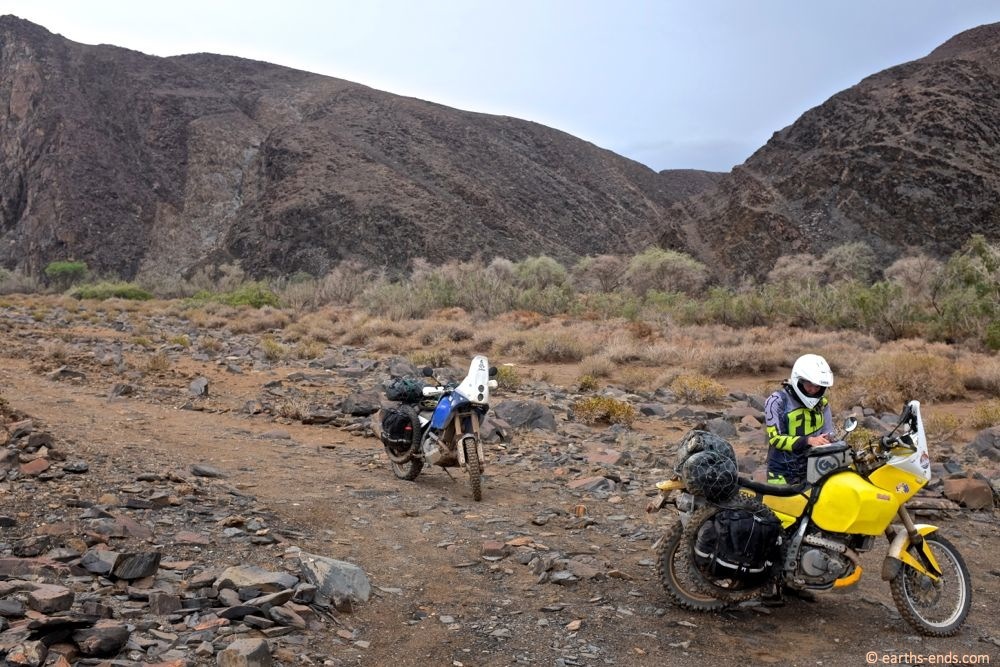
These random rocky sections meant dropping pressures wasn’t an option
I was extremely anxious about possibly running into one of the valley’s black rhinos. There are supposed to be a decent number of them there so we had our intercoms on and eyes peeled, however the deep sand and steep valley walls was hardly a good place to outmaneuver and outrun a charging rhino. Fortunately it seems that rhinos know that vehicles contain humans which they have learnt through sad experience are bad news for them. They apparently run for their lives at the sound of an engine which is a sad reflection on us and the effects of poaching, but we were glad for it – it increases the chances of both parties living a full life.
On our ride down the riverbed we were treated to the most remarkable display of geology I have ever seen. The folding was more impressive than anything I have ever seen before in real life or even in a textbook. It is a rare thing indeed to see such wonderful displays on the kilometre scale. Utterly remarkable. River valleys often reveal incredible geology but this was just ridiculous.

Incredible folding
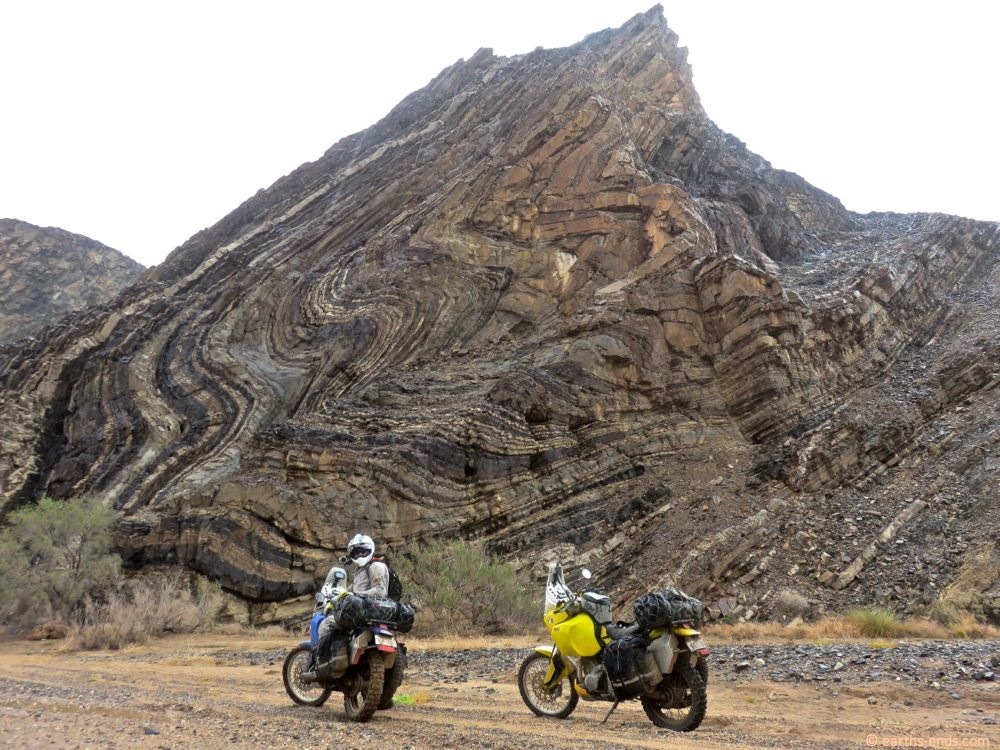
And more of the same
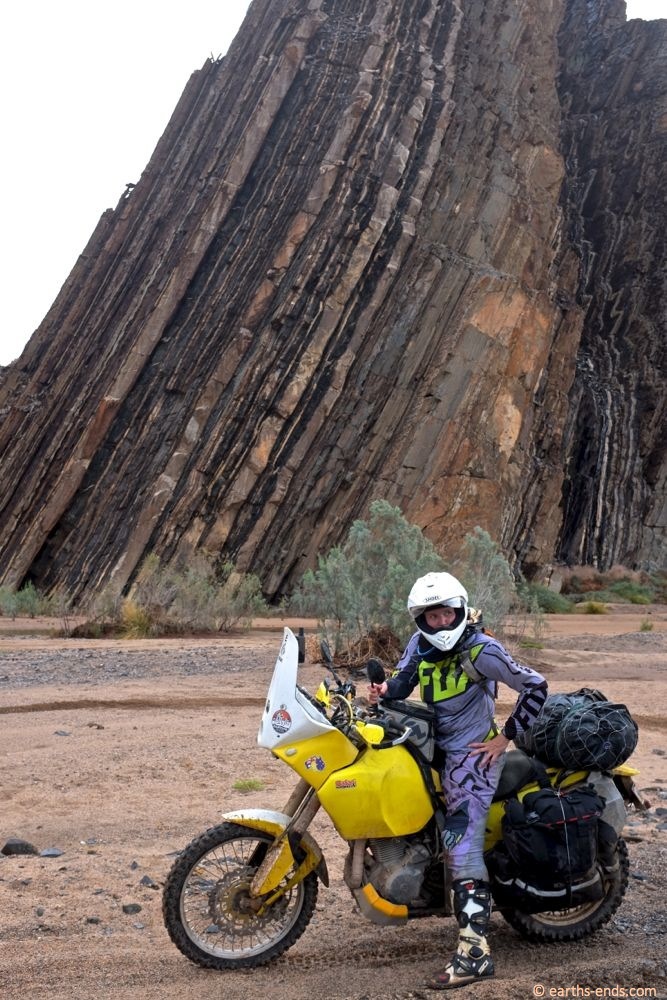
The geology just got better and better but sadly we were too busy staying upright to capture a lot of it
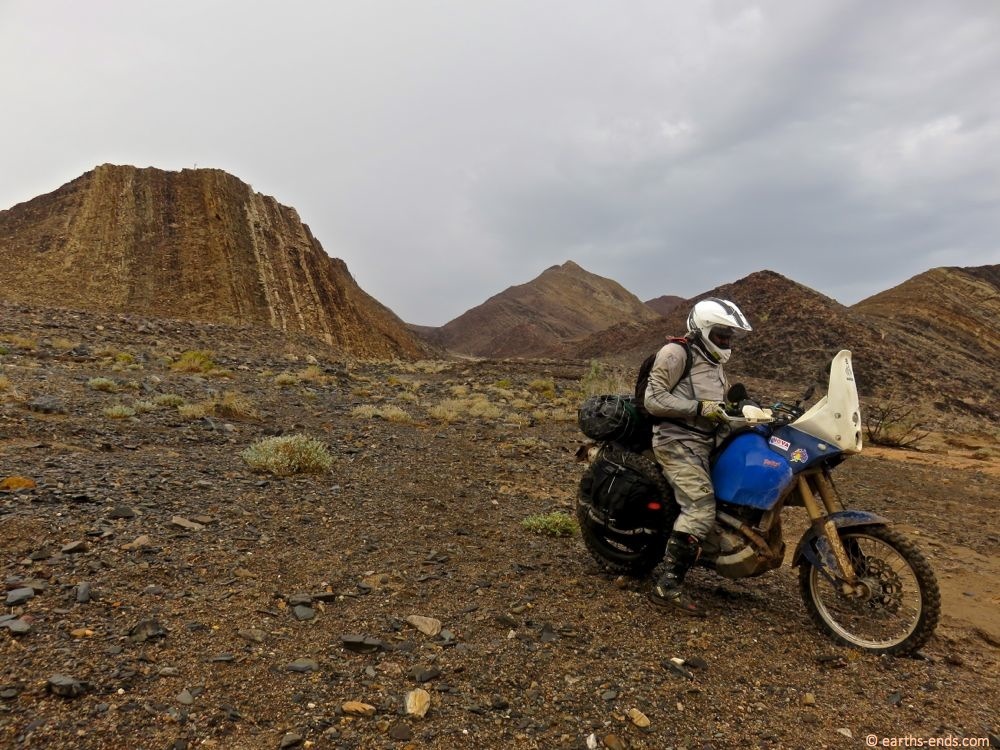
Other worldly
Finally we came upon what the GPS told us was our route out of the valley and onwards to Twyfelfontein. It was a steep track up the valley walls over wet, sharp and slatey rocks. It was such a narrow track it looked like it could only just fit a 4WD. By this point we were certain the young Swiss couple didn’t come this way but we weren’t at all certain we could manage it on the full loaded dirt tractors. Mick went ahead first to prove the route and if it was alright he’d honk his horn to tell me to come up. Not long afterward Mick came down and said that route was not really suitable for us (read:me) which was a rarity as our DRs can really get just about anywhere and I can generally hold my own. But the bigger issue was that we didn’t know how bad it would get and for how long.
Link to Video hosted on Vimeo
VIDEO Attempting Divorce Pass on slippery wet rocks. Hard work.
So we continued on up the riverbed looking for a better way out of the steep sided valley. After all the river sand, Mick did some exploring for a better, more hard-packed line near the valley walls. What he found however was the absolute opposite, a total quagmire. He managed to get his bike proper bogged in a slimy silty mess at the same time as I hit thick mud and buried my bike about 100m away. Both bikes were so stuck neither of us could extricate themselves without help. We managed to get ourselves covered head to toe in mud in the process but we go the bikes free and resigned ourselves to the thick sand in the middle of the riverbed. I’ll take sand over mud any day.
Just at that point however it started to rain pretty heavily. Now things were getting interesting. Bloody serious in fact is probably a more apt description; a riverbed in a downpour is hardly a place you want to be. However, it seemed the best thing to do was to continue up the valley and find some higher ground.
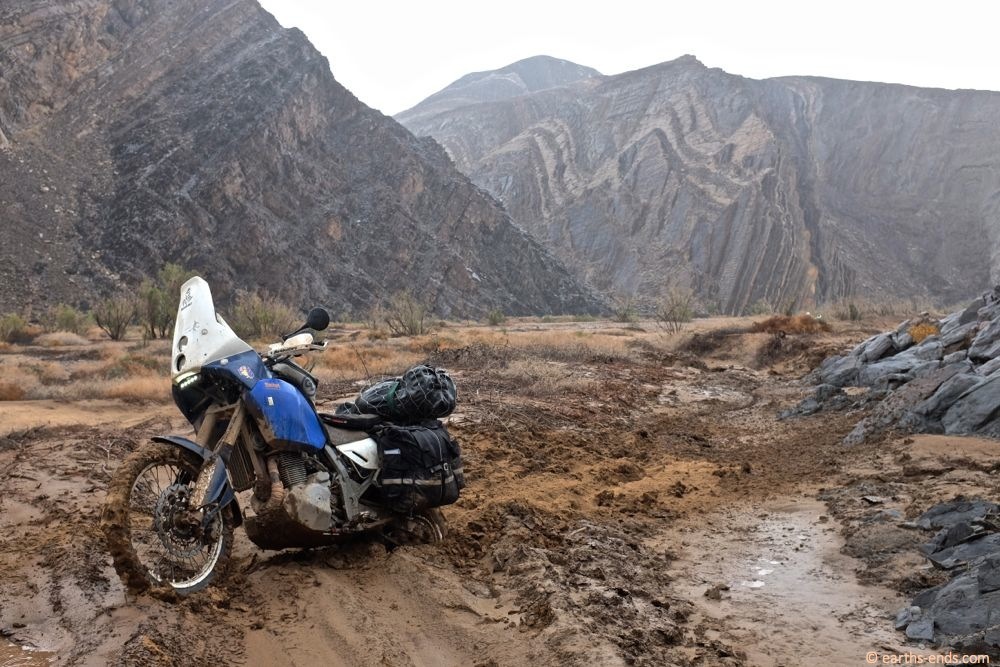
Ah shet, ah shet, eim bogged, eim bogged as bru…

The start of the flash flood. Giddy up.
So we rode onwards. And the river rose to meet us, going from empty to 20cm of fast flowing sandy water in just a minute of two. It was quite a cool, though slightly tense experience riding against the current in a rising river. Things weren’t out of control but far from ideal either. We weren’t all that worried by the riding as we both have experience in deep water, but what was quite worrying was the pretty limited number of options we had. We were stuck in a sandy steep sided riverbed quickly filling with water….
It seemed best to just keep going while we still could and find some higher ground ASAP. One thing in our favour was the river valley was pretty wide so it would take a lot of rain to leave us with no options for escape. If worst came to worst we could gun it out of the main track (which was now the river) up the walls of the valley and drag the bikes up as high as we could go and perch ourselves there until the water receded.

Things were getting interesting
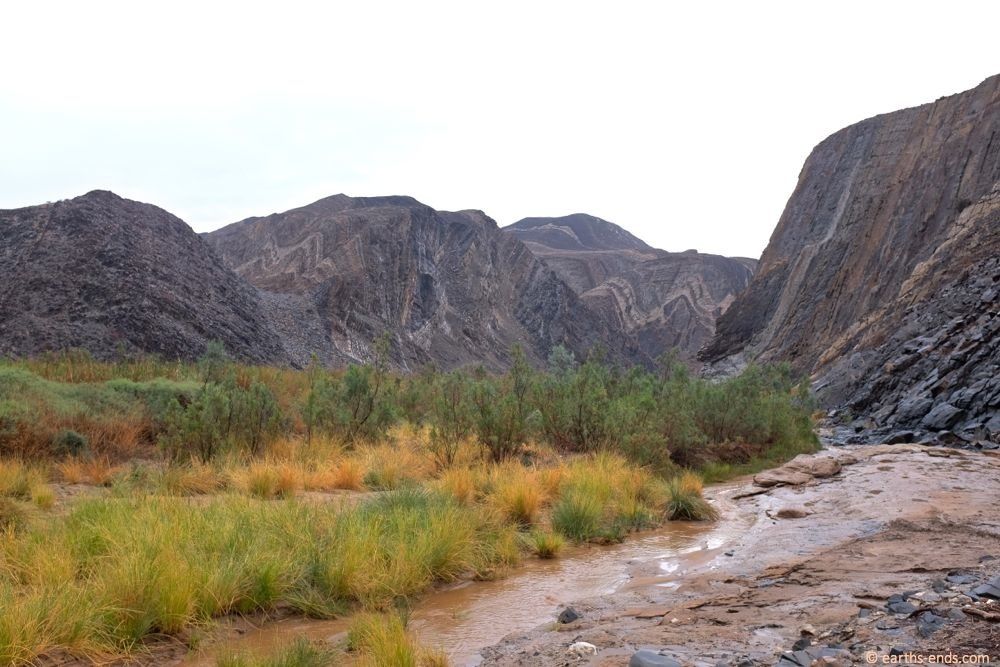
Our old road and new river
We continued on like this for another kilometer or more, by now we were riding in 30cm of fast water and rising. The water had a decent current behind it and we were occasionally dropping into a half meter deep holes eroded by the flowing water and negotiating sizeable submerged rocks to boot. It was a case where you do your best riding when the stakes are high and no bike drownings occurred. In fact, it was great fun. The added bonus was that the bikes were getting a thorough cleaning with fresh water after our time on the Skeleton Coast. The salt from us blatting up the beach had done a total number on our brand new chains and sprockets and the bike as a whole. We couldn’t spare a drop of precious drinking water to rinse them off so instead had covered the chains and frame in WD40, with marginal success. Now, still far from fresh water sources we get an unexpected bike bath. We were thrilled.
Eventually we came upon some higher ground that would get the bikes about 3m and the tent about 4m above the valley bottom, and decided to stop here for the night. There was about 2 hours until sundown, but it was still raining, the water was still rising, there were nasty clouds in the distance upstream and the ground was higher here than any place we had seen it in the last 15km. So we maneuvered the bikes up as high as we could and set up camp. We got to have a good bath in the river and took the chance to filter some drinking/cooking water with our excellent little MSR gravity fed water filter we carry for emergencies. In these parts of Namibia we were looking to carry about 12L each, including our bashplates 3L of emergency water at all times.
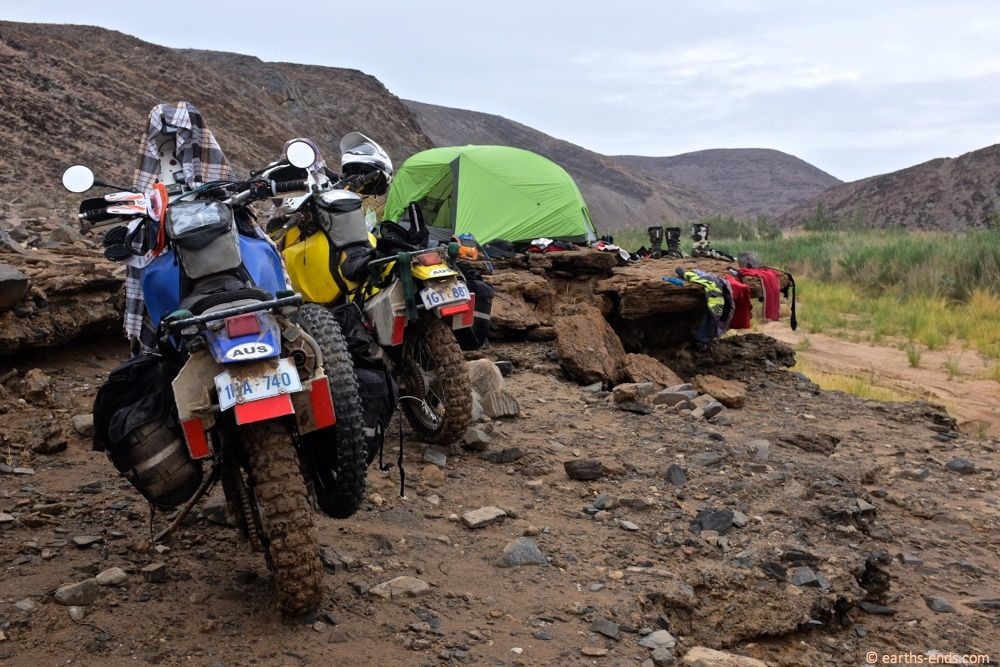
Higher ground
By consulting the map and the GPS together we realised we had definitely taken a different route to Twyfelfontein than the one we had intended. Our current ‘incorrect’ route would take us down the Ugab and back towards the White Lady Campground that we had come from days previous. This is why a GPS alone is not so good. We would have learnt this earlier had we consulted the map while at Rhino Camp and had not assumed, like a total geologist, that the poor Swiss people would (in their second language) correctly identify what exactly constitutes a river valley. Our immediate thought was that we had inadvertently stumbled across what would have to be one of the coolest off-road routes in all of Namibia; White Lady<->Skeleton Coast in the Ugab River. Epic riding, complete with desert rhinos, elephants and lions! We had the will and enough water and food to continue but we had insufficient fuel to sensibly add about 90km of tough sand riding to an already long route. Our fuel consumption in sand like this can be as low as 12km/L.
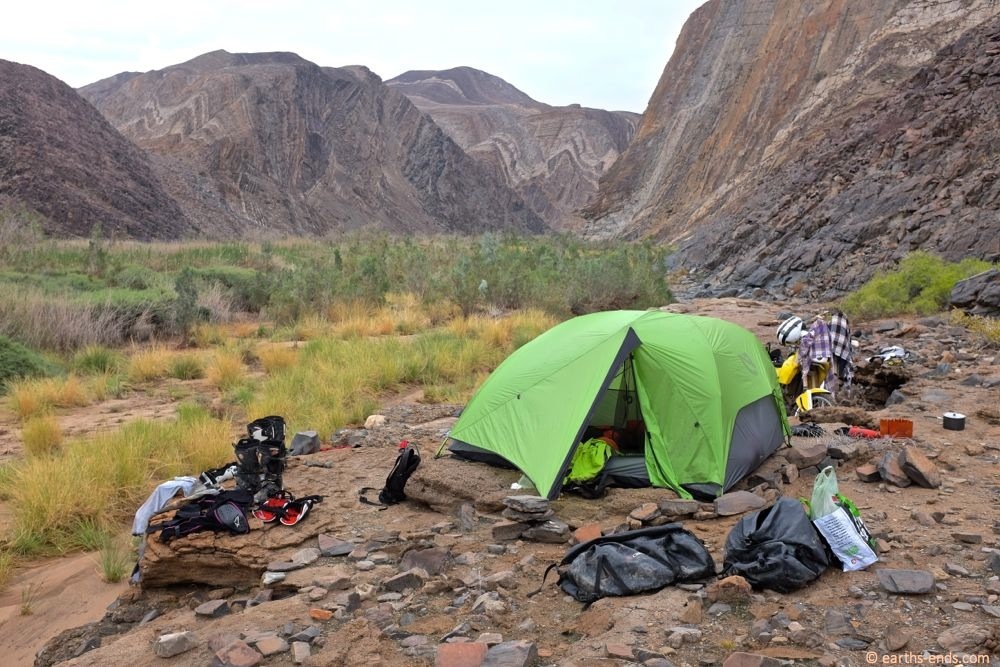
Our home the next morning – gear spread everywhere in the sun.
More significantly though, we had no intel about the trail whatsoever and with on and off rain through the night there was obvious further floodwater risk. We were kicking ourselves for not talking to more people about potential routes and filling the secondary tanks. We are calculated risk takers and don’t mind pushing the envelope once we’ve done the necessary preparation but being off the cuff reckless is just not how we roll. We aim to be self-sufficient at all times and never want to feature in the many cautionary tales of biker folly. So we resolved to put the Ugab River valley ride on our future riding bucket list (outside of the wet season) and to be grateful for the awesome and unintended trail we had done to this point.
There was nothing else for it. We had to do the riverbed in reverse and get back to the main track. Fortunately, despite our extremely isolated location, we were able to drown our sorrows/celebrate the days difficult ride. Our friends Freidel and Tony in Windhoek had given us baby Amarula bottles to open in case of emergency. This seemed like as good a time as any.
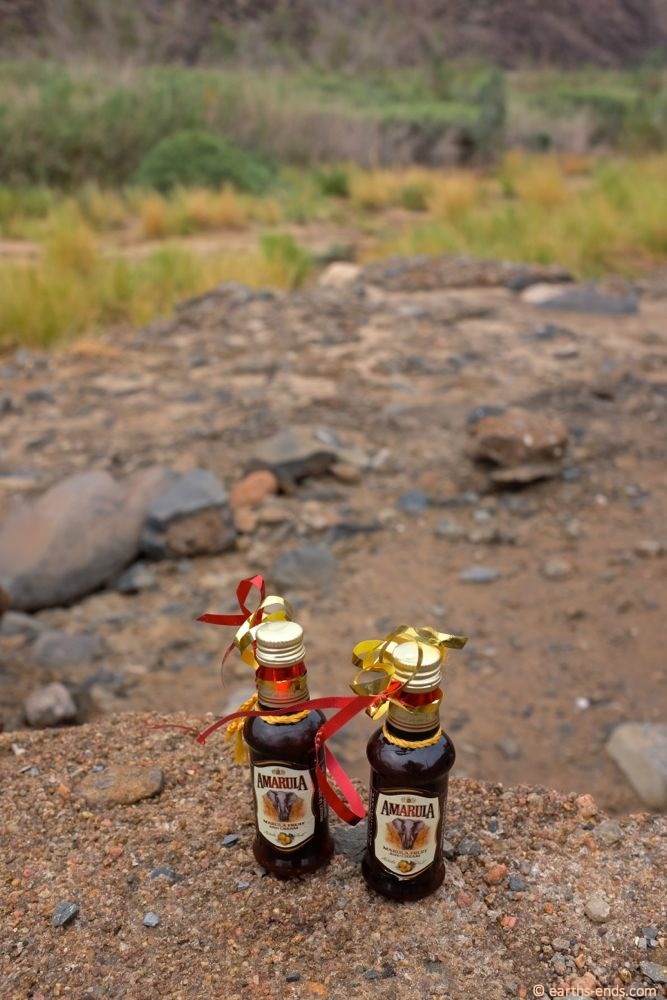
Open in case of emergency baby bottles of booze
Though all the excitement we unfortunately forgot that our GoPro was not in its waterproof casing. We did having more pressing matters to attend to after all. Having a high cost bit of kit die on the trip is really disappointing but what can you do? First a camera, now a GoPro… Gutted!
It stopped raining hard and we settled in for the night. We whipped up a not so gourmet meal of soya mince and instant mashed potato. I went to sleep feeling a bit unwell and woke up in the middle of the night and managed to get my head out of the tent before vomiting. Like a lot. Mick, with his iron clad guts, was totally fine apart from having to hear me violently rid myself of the soya chunks mascaraing as mince, potentially over a bunch of our stuff in the vestibule. For me, what I found most disturbing, was that the taste of the soya mince coming up was near indistinguishable from its taste going down. I have thus resolved never to partake in soya mince again. I had already been perturbed by its tenuous claim as a food fit for human consumption for some time.
It was one of those bouts of vomiting that is remarkably therapeutic. Immediately afterward I felt excellent and went straight back to sleep. I’m not sure if it was the highly salty soya mince after days of bland food that disagreed with me, bad water or heat stress from the day’s riding that was responsible. Perhaps it was a combination of all three. Either way the worst was over.
I made the mistake of forgetting to take some rehydration sachets after the episode so really suffered the next morning. I struggled to eat anything and only managed a spoonful of peanut butter and a handful of nuts.
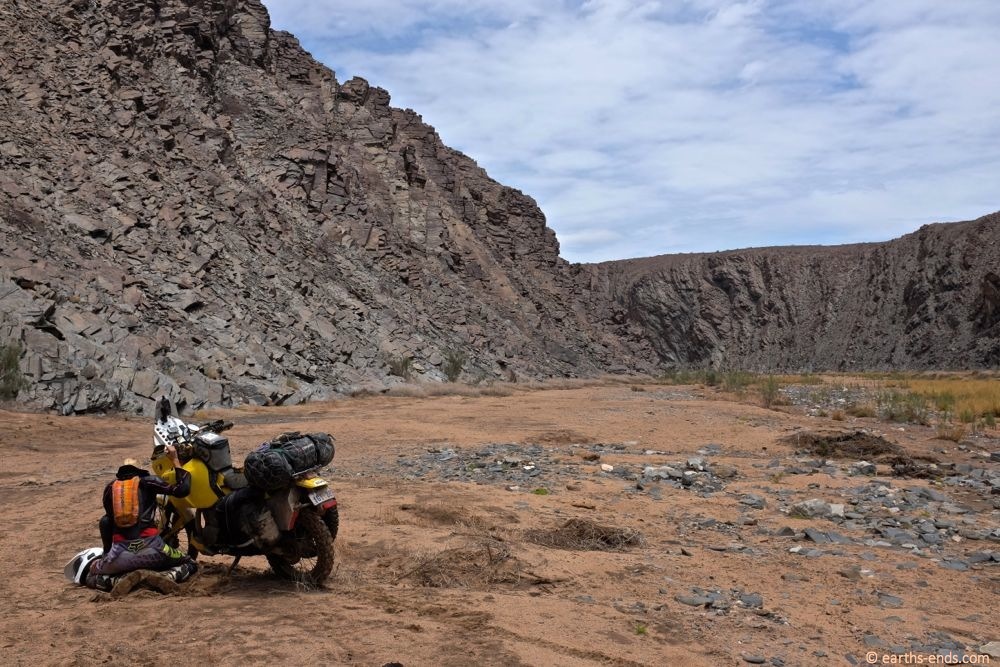
Feeling less than awesome. Note the freshly exposed rocks everywhere, and the pushed over grass, which hid the rocks and holes. Mick meanwhile is “hurry up and spew lady we’ve got riding to do!”
Once our gear was dry we packed up camp and started on our way back to Rhino Camp. By now the water had receded completely and the route was filled with fine silt, exposed rocks and many holes. I already tired myself out getting the bike bogged in the mud almost instantly and then, just as I was getting a rhythm going, I rode straight into a deep hole. The bike’s front wheel went straight into the gaping chasm and not having had the reaction time to brace myself, my face went straight into the fairing and the GPS mount as I had neglected to shut my visor due to the heat. I absolutely smashed in and was surprised to see the fairing still intact. It bloody hurt and I’m not going to lie – it made me cry. Fortunately though I was wearing my large fox sunglasses which absorbed a lot of the impact. Though I was still bruised and swollen for a few days. If I’d been wearing my other sunglasses or none at all I could have really done some damage. My new sunnies that I got for Christmas paid the price, and were now all covered in scratches…… and this is why I can’t have nice things.
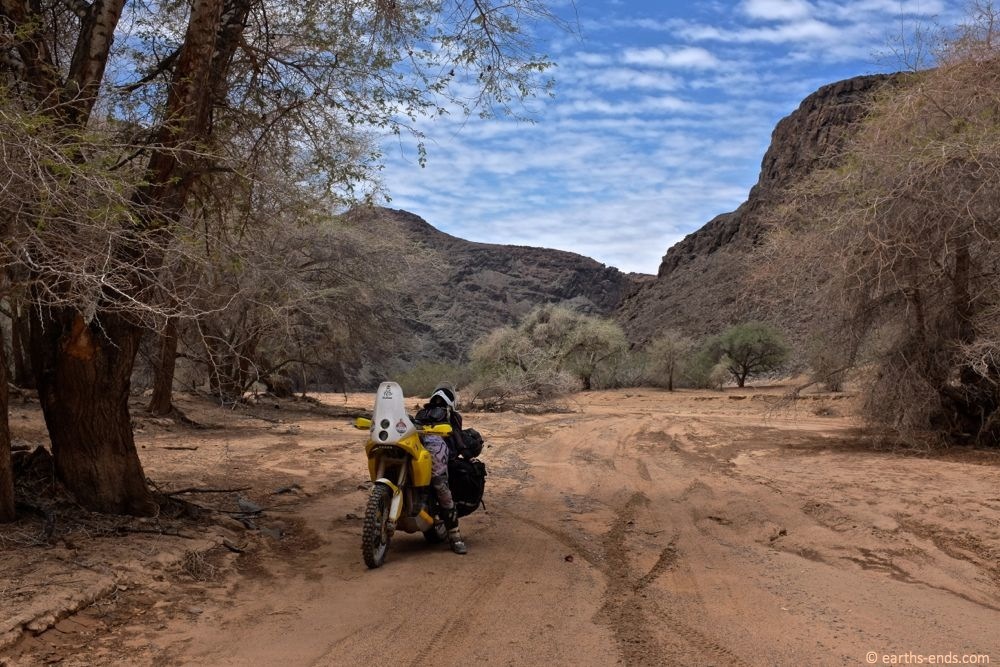
30km of HARD work
Once we got out of the mud and onto the sand I felt bloody awful, my face hurt, I was overheating and wanted to be sick. I had no idea how I was going to manage this bloody sand again. I knew if I had just one fall, that would be the very last of my energy reserves gone. It made a huge difference having the intercoms working again as Mick was able to ride behind me shouting encouragement and kindly agreeing with my deluded claims that I was riding just like Laia Sanz.
When the terrain gets really difficult I prefer to be in front. While I lose the advance warning of hazards and the benefit of knowing the better wheel track to take, I gain by being able to focus better. I also find I struggle more if I see someone in front of me struggling. It’s really off putting to me. It is almost like if I see them have difficulty I give myself permission to similarly struggle. Mick and I often joke that I need to see a motorbiking councilor. So much of my riding is based on confidence not ability and it frustrates Mick to no end watching me negotiate a heinously challenging obstacle with ease one minute than struggling the next minute with something easy ‘because I have a bad feeling’. Really it is pretty stupid and amusing… but more stupid than amusing.
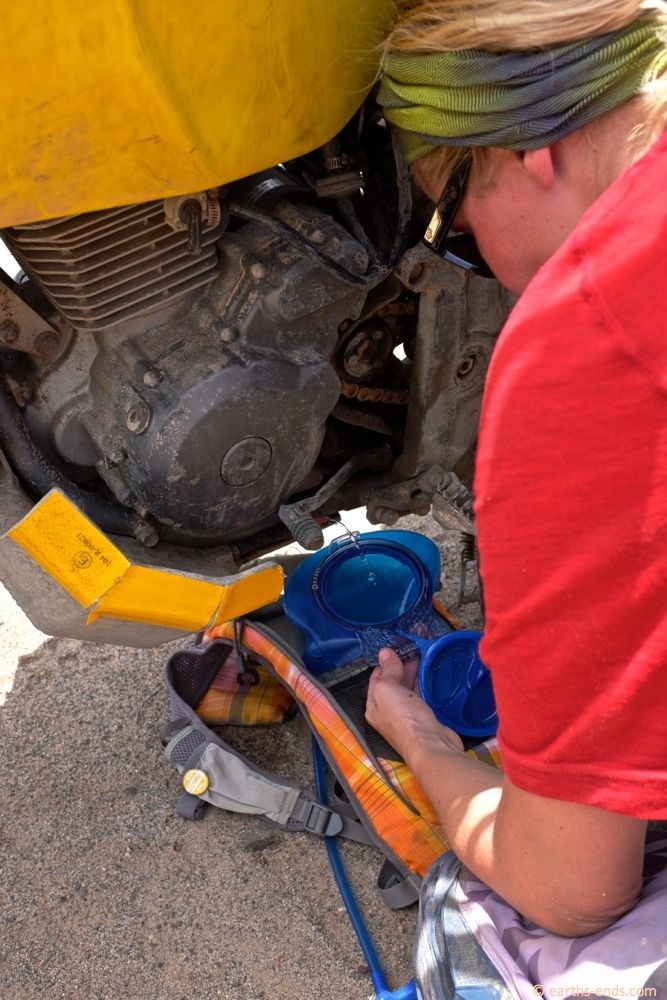
Using our emergency water storage
Somehow I managed to pull it off (seriously I was on fire that day) and before we knew it we were back at Rhino Camp. What a route it was! What a challenge! What a view! What an awesome wrong turn to have taken! Once there we refilled our camelbaks which were bone dry with our efforts in the sand. Not knowing what was behind my vomiting episode we thought it safest for me to stick to the best source of water we had, which in this case was the 3L of bottled water that was stored in my bashplate. While hot enough to brew tea or sterilise medical implements, it was the safest bet as a second dehydrating episode would throw a massive spanner in the works for our plans to do some serious, remote riding further north. It was summer, there was near to no-one around. We couldn’t afford to get dehydrated again.
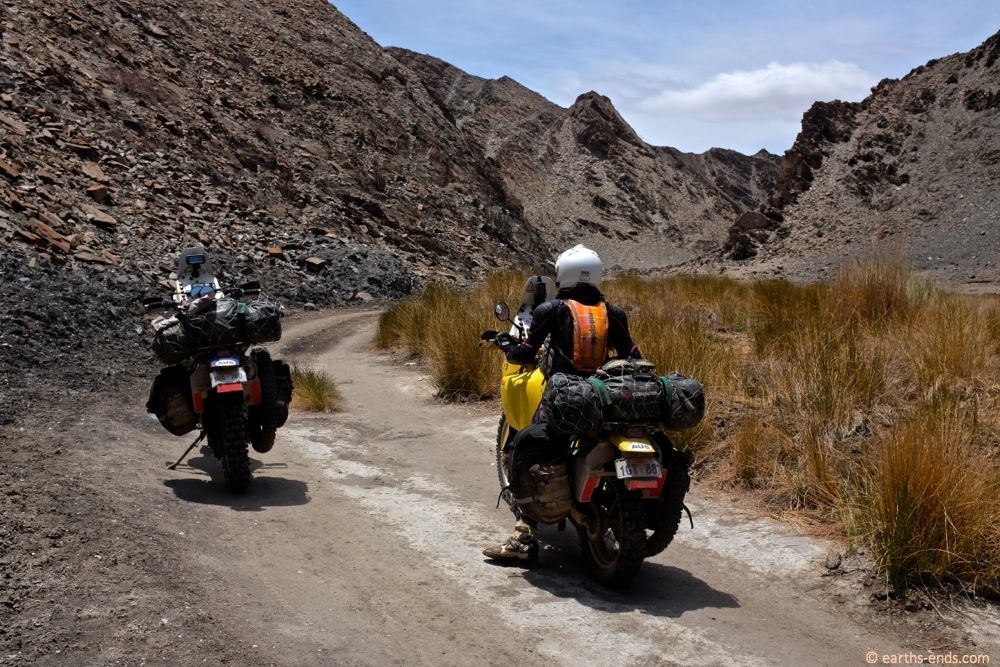
The way we should have been going all along
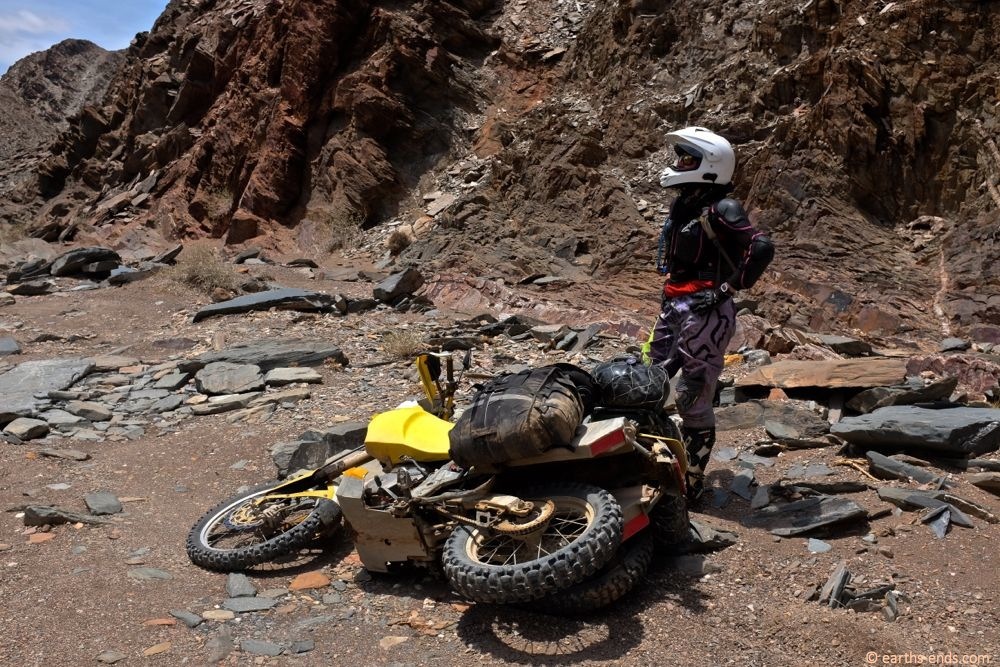
Got knocked way off line by big slaty rocky which tipped over and dropped it. Not happy.
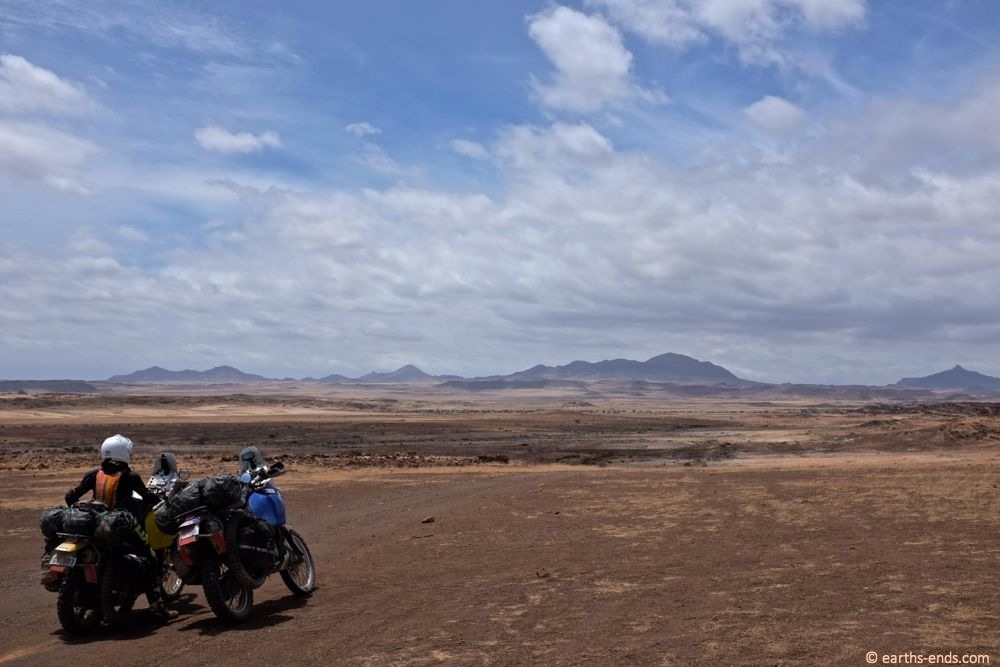
Coming out of the “Valley of Desolation 4WD Trail”, as named on Tracks 4 Africa
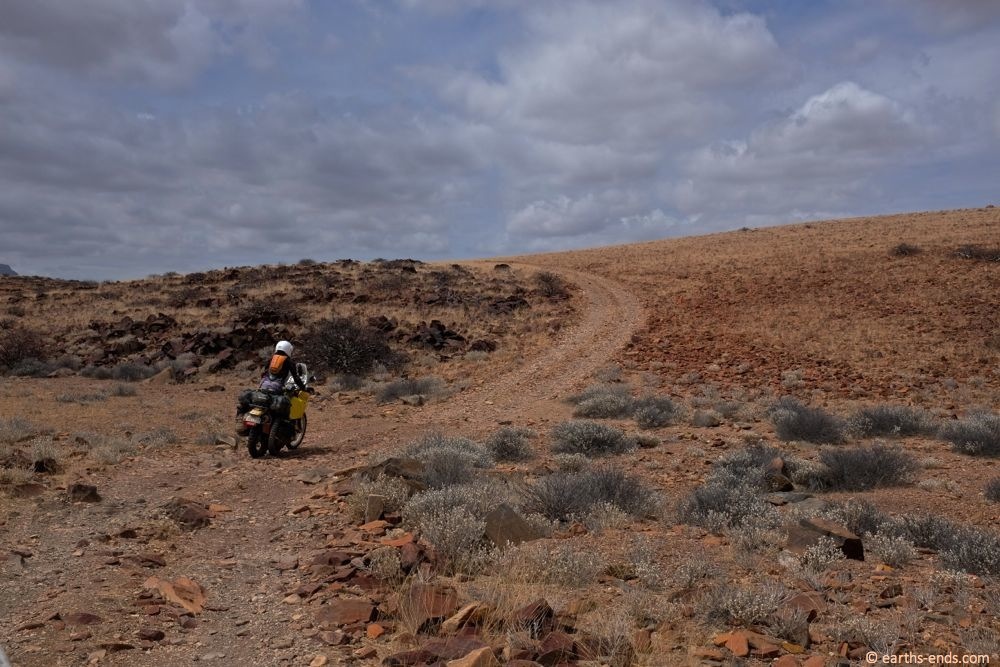
The trail was not technical but just relentless up down left right rocks sand constant non-stop.
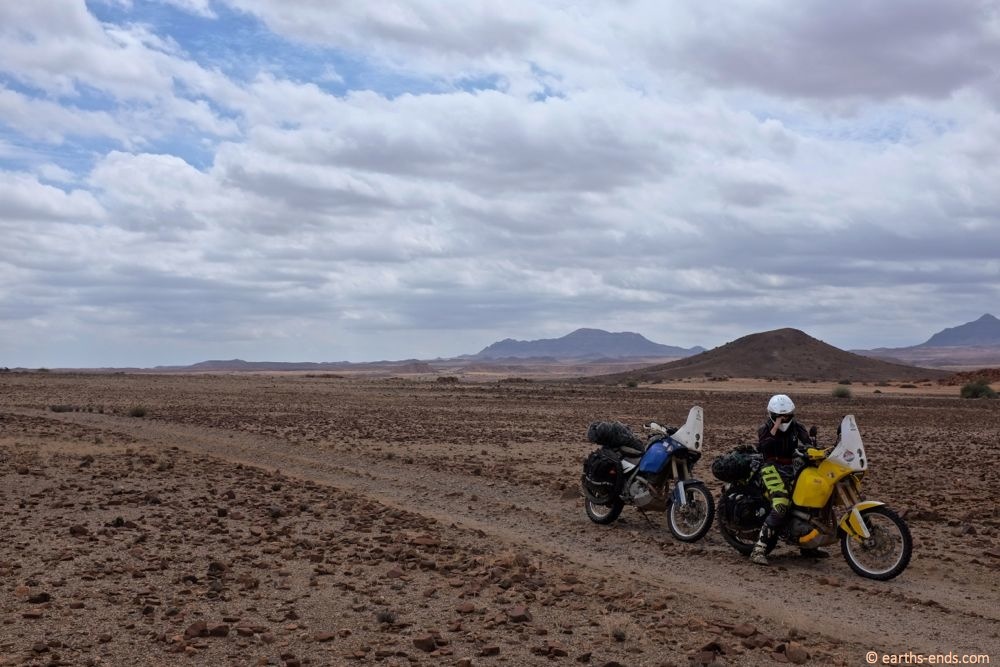
Breather/photo op
Now on the ‘right’ back trail to Twyfelfontein, it was hot and we were knackered but there was no escaping the fact that the trail was fantastic fun. It was worlds easier than the way we came from but hardly easy and in our mind it didn’t warrant the comment on our GPS maps that it was for serious 4WD vehicles only. It took us almost 2 and ¾ hours (with ample photo stops) to do the 75km. It was constant off-road, though not all that technically challenging, it was absolutely relentless rocks and sand and corrugations. There was barely a moment you could sit and switch off. So much so that it made me think there was no way the route was designed by a non-bike rider. It has to have been to most fun, winding, inefficient, not-direct line of a road I have ever taken. Despite my aching muscles and fatigue I found it rather fabulous.
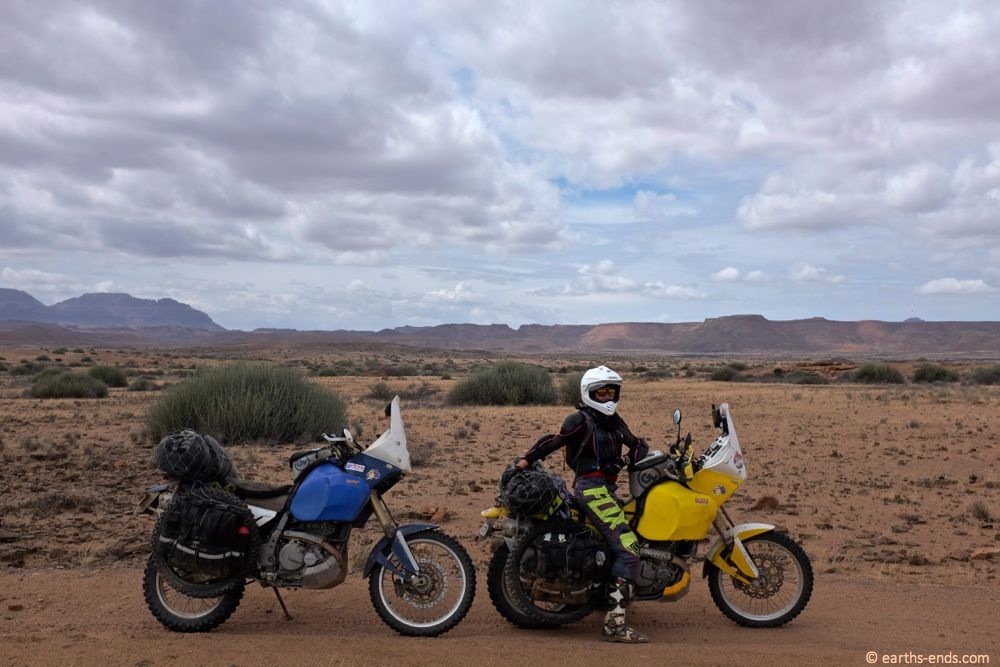
The bush in the background is one of a couple highly toxic plants in Namibia, known to kill people who use it for cooking. Its is attributed to the deaths of 11 miners in Uis
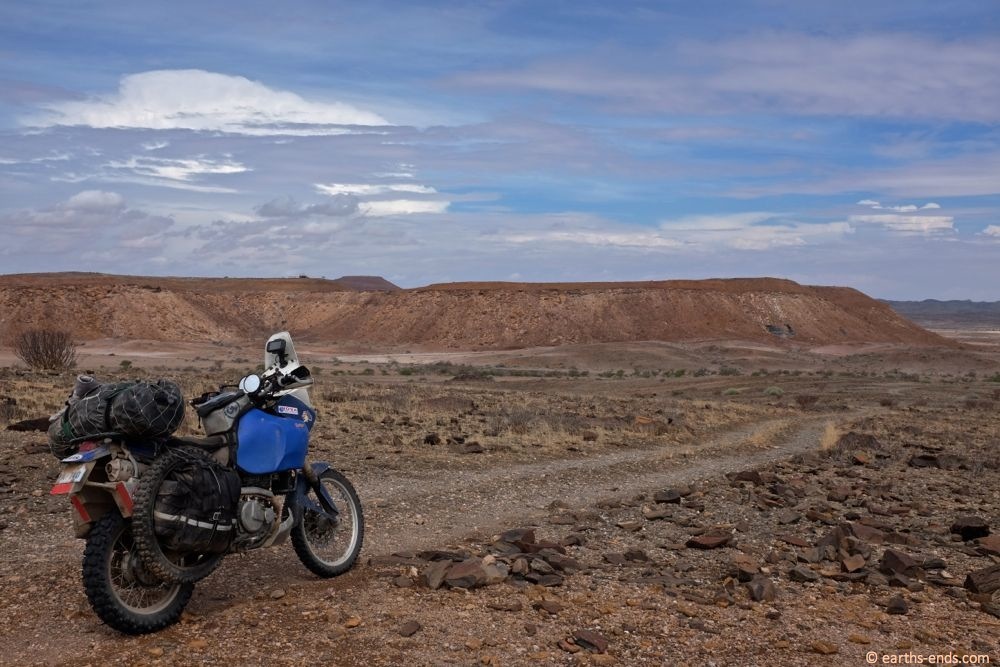
Getting close to the back of Burnt Mountain now
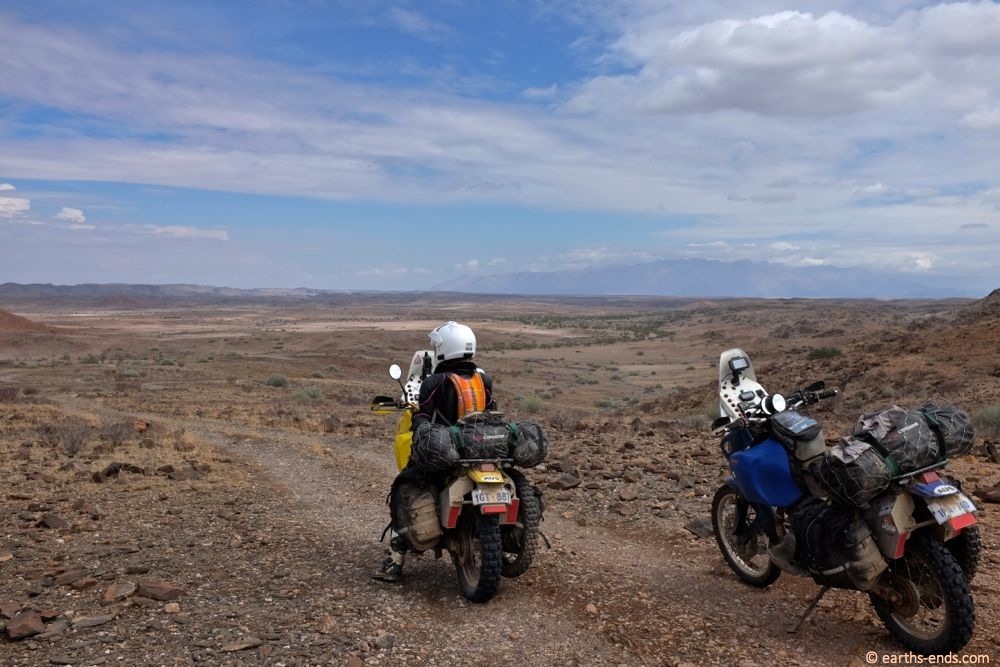
Some nice views looking down from Doros Crater

Road signs Damaraland….. it would be possible to navigate without a GPS but you would need a good set of map and be seriously on the ball
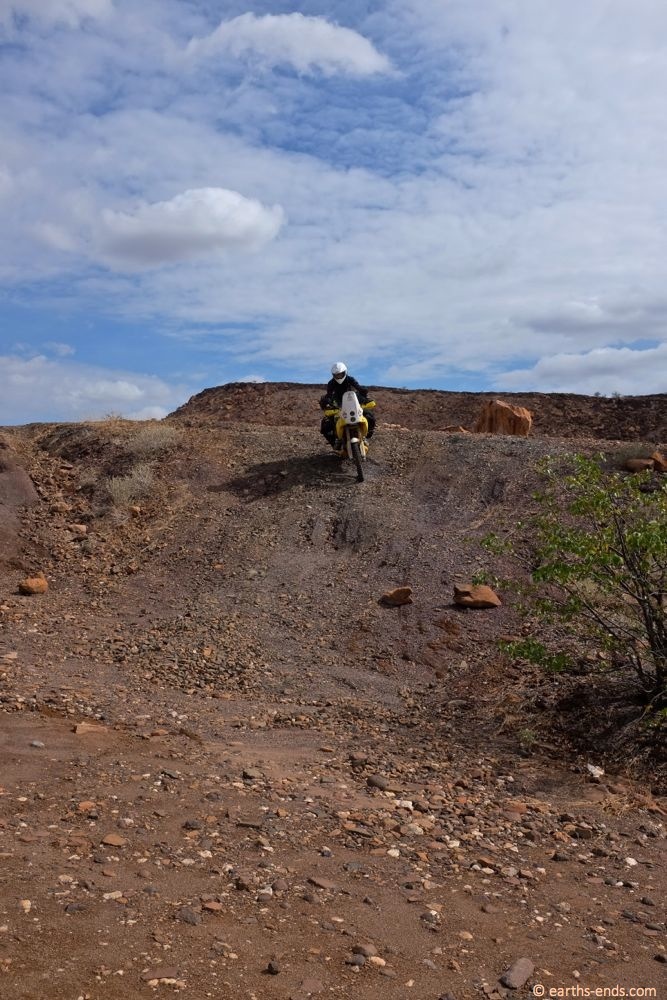
The last bit of trail. Nearly there!
We were so relieved to arrive at Twyfelfontein as we were in desperate need of food and a rock shandy. We fronted up to the Twyfelfontein Country Lodge and we found it was so far outside our budget that we felt embarrassed to have even enquired. However, we could afford their rock shandys and annihilated a couple of them in quick succession. I then begged the closed kitchen to make us some food, pleading that a microwaved potato would suffice. They sorted us out with one of the best toasted sandwiches and hot chips I have ever tasted. Seriously is there anything better then getting through some epic riding in tough conditions, eating and drinking your fill and recapping the riding with a cold beverage in hand? I think no. Not that day anyway.
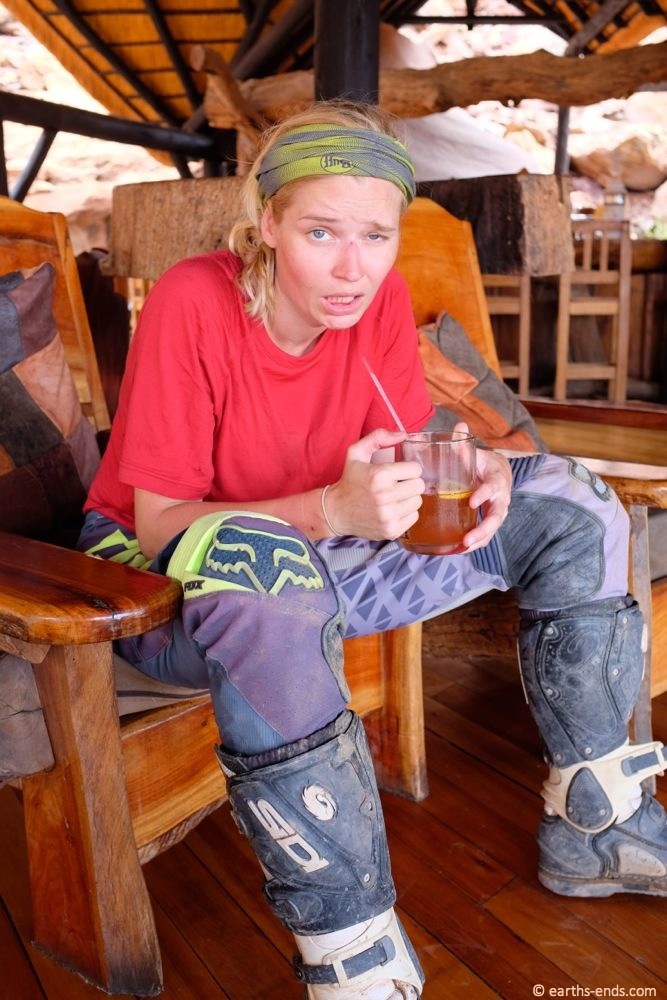
‘Maybe she’s born with it….maybe its Maybelline’
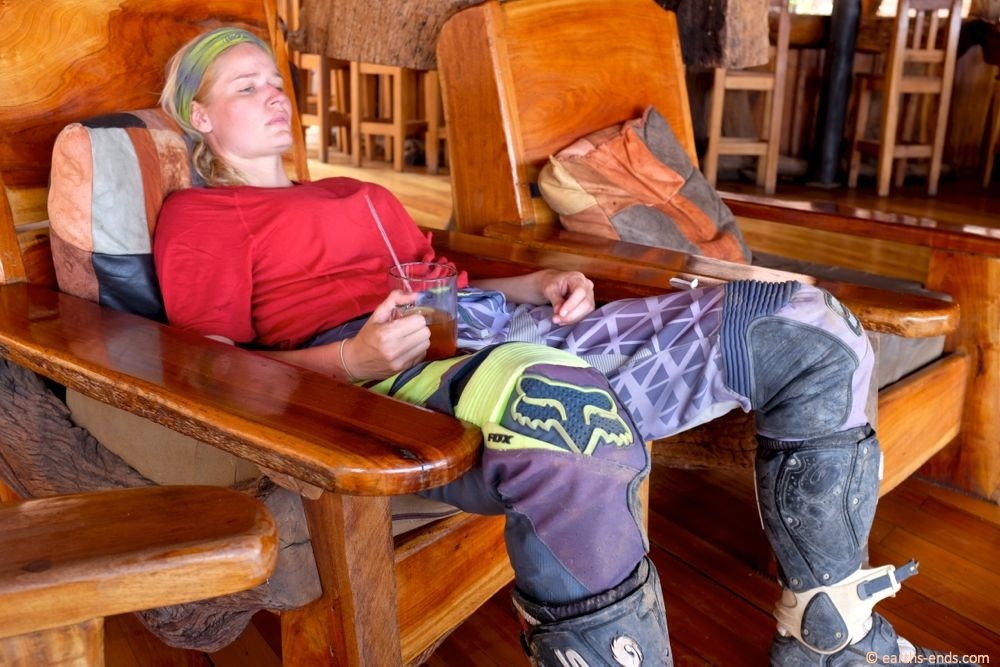
Exhausted to infinity

And this is why you wear a jersey
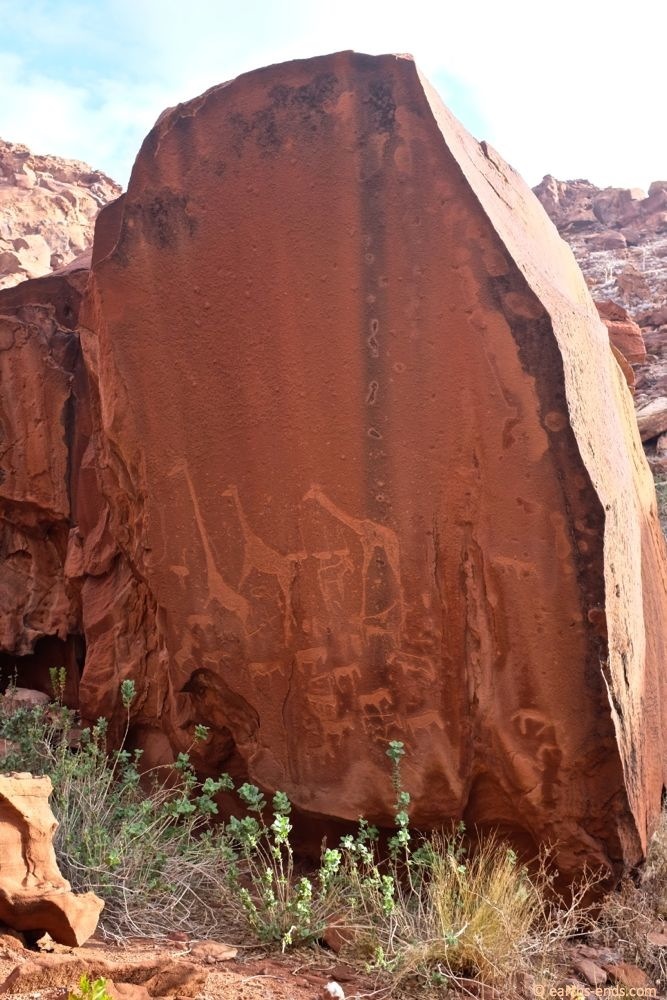
San rock engravings at the lodge
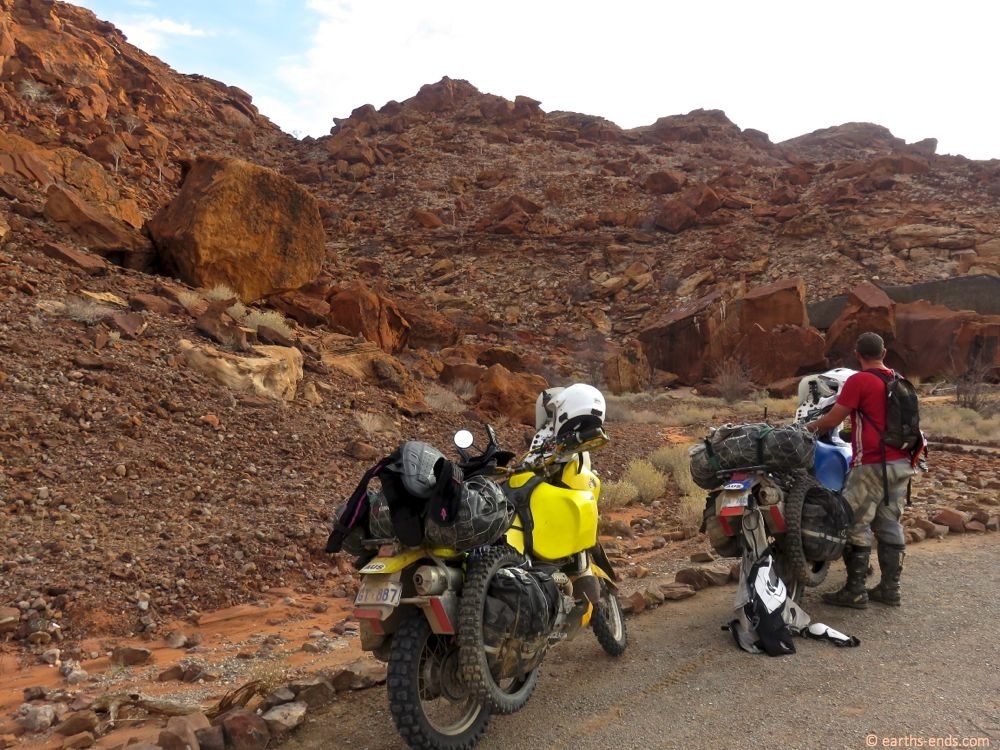
Leaving the lodge. It was way above our budget.
We then made our way to an impressive resort called Mowani Mountain Lodge. I’ve mentioned before that Namibia has camping or luxury lodges and nothing in between. Well, the benefit of this is that often the expensive luxury lodges have a campsite as well and while I’m sure they prefer to keep the camping riffraff away from the facilities meant for the $400 a night people, our experience is that workers from these establishments are generally too polite to tell us to push off and be poor in the confines of the campsite. So we just set ourselves up on the comfortable sofas of the lodge, enjoy the views and indulge in the four/five star trapping at campers’ rates. We may have pushed things a bit far one day by taking a piece of the complimentary afternoon chocolate cake that was probably left out just for lodge guests. But seriously, what kind of person puts a chocolate cake unsupervised, near me and expects it to sit there unmolested? A fool, that is the kind of person. A damned fool.
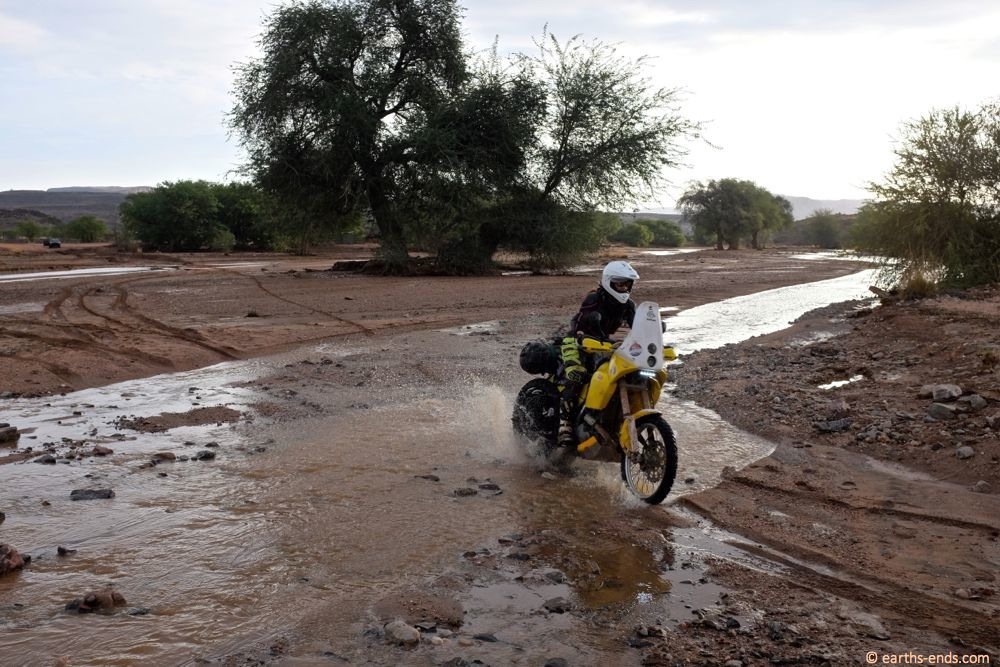
Crossing the Aba Huab River on the way to Mowani. Any shallower and we’d need a bongo truck…
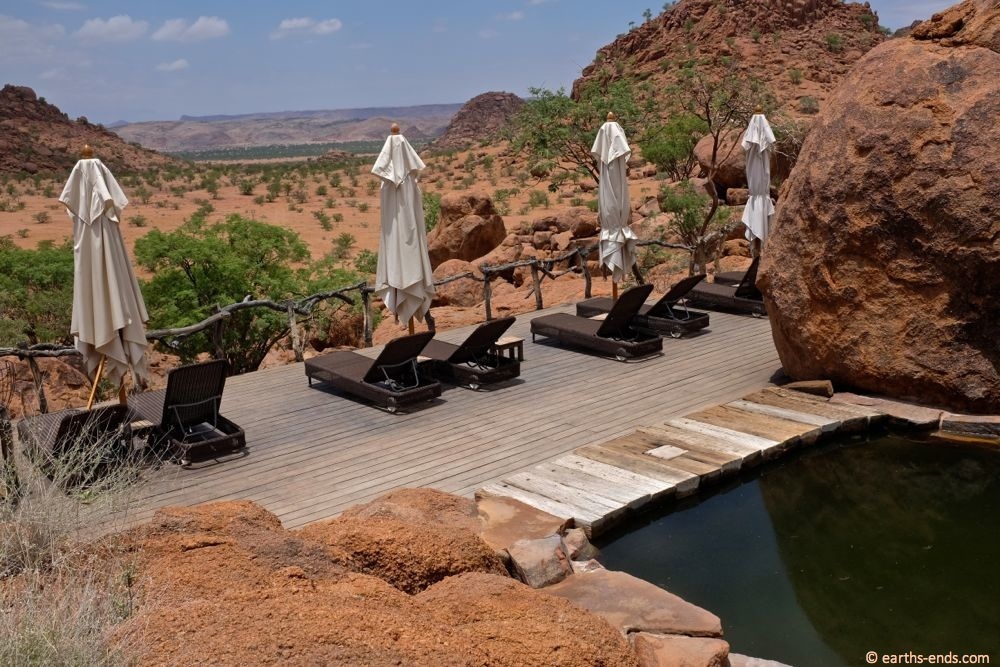
Not a bad spot at all
Anyway we decided to have a rest day at Mowani, which was spent catching up on blog writing and eating fresh vegetables and fruit (a luxury in itself) and skillfully avoiding the stink eye being shot at us from the stroppy South African lady who managed the place. Whatever lady, we were the only people there and we bought lunch so the lodge was fair game to us. The campground was far from cheap at $22 per person per night but it was worth the expense. You got your own impressively decorated toilet and shower block which looked nothing like an outdoor toilet block at all. Every evening and morning before you awoke a worker would come and light a fire under the simple wood-fired heat exchanger known as a donkey in these parts. This gave a huge supply of hot water morning and night.
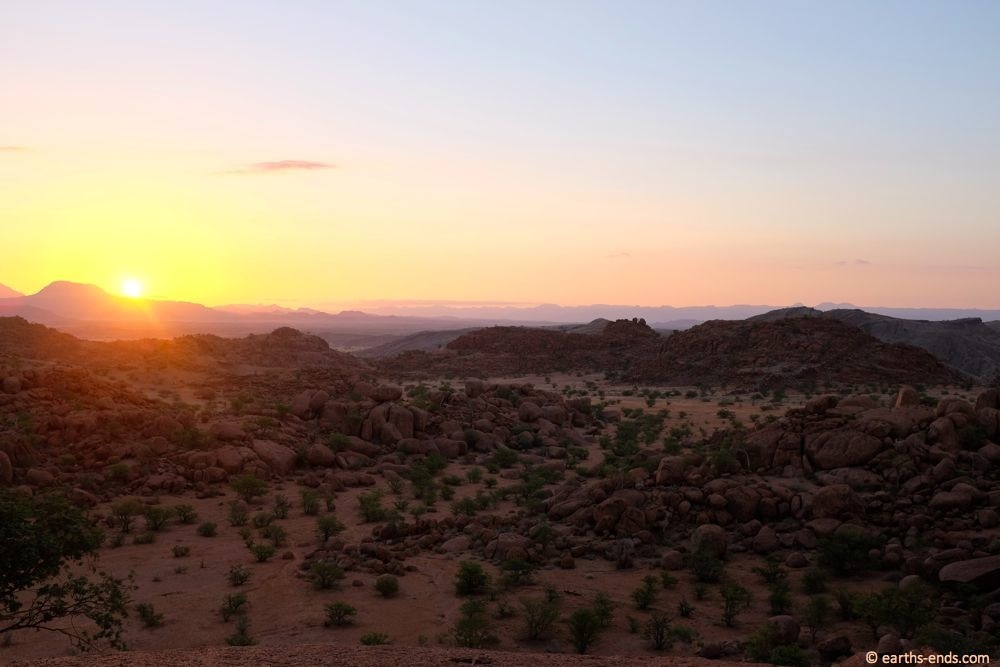
Sundowners at the lodge
An added delight of the place was that there were amazing granite boulders everywhere displaying the full range of textures and various other geology-like things that I shall resist the urge to bore you with. The most exciting stuff however was the examples of thermal shock. Thermal shock happens when the boulders get so hot through the day only to have rapid cooling occur over night that causes rocks to split apart. Here is a stellar example.

Seriously think how this would have to have happened to end up this way
Like a lot of places marked on Namibian maps, Twyfelfontein isn’t actually a town at all and there is pretty much nothing there but a handful of lodges and the stone engravings that make the place famous. The name Twyfelfontein means “doubtful spring” and it only takes a few minutes outside for the name to make sense. It is a desolate, dry and hot place to put it mildly. However despite this we again found ourselves having to negotiate the flowing Aba Huab River, this time with a respectable level of water in it. With the country up this way being so flat lying, rivers can become torrents without a cloud in the sky as rainwater gets carried from great distances. There were buses of tourists waiting for the river to go down enough to cross. Mick crossed first while I watched his line. This gave the tourists enough time to notice I was a chick and let out an excited laugh that translated to ‘Ha! This will be good’ and whip the camera’s out in morbid anticipation. I was thus faced with the conflicting desires of wanting to put on a good show demonstrating textbook technique and wanting to keep my boots dry. I settled for a middle ground of going in fast in the shallow part, staying upright and lifting my feet as I got further away from the peanut gallery. I figured impressing a bunch of Germans in socks and sandals would be little consolation in the event of foot rot.
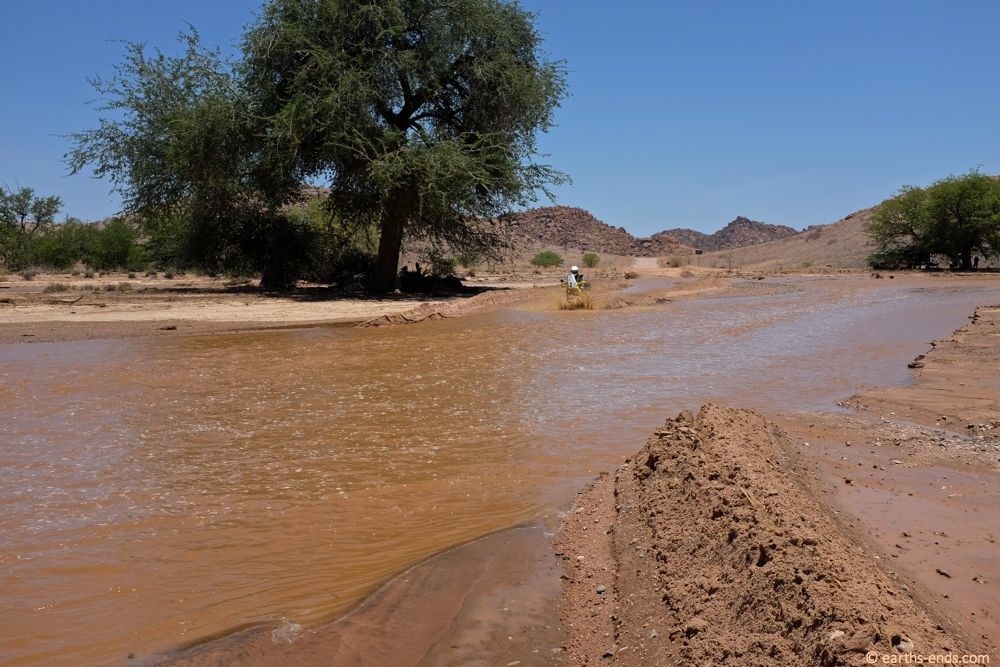
Finding a nice little deep spot that wasn’t supposed to be there….that is why you take it slow though water….unless you have random elderly European tourists to impress
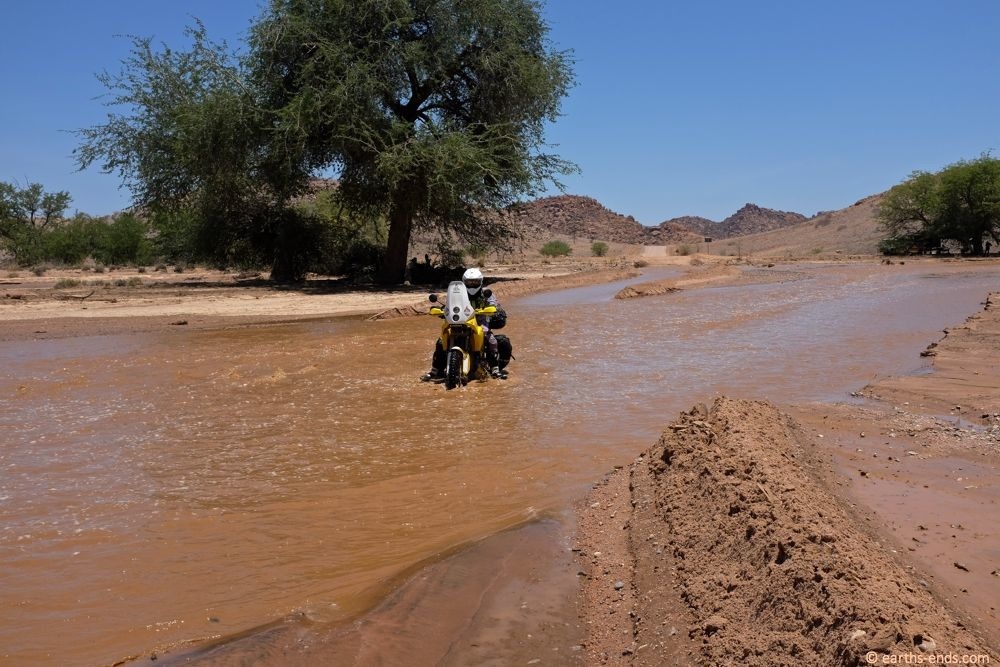
Trying to keep my feet dry
Our first task for the day was to source more fuel and we had been told by people and that fuel was available at Twyfelfontein workshop. Unfortunately while that was once true it was no longer the case and they were only selling diesel. We did a stocktake of the contents of our tanks, including a bit left in my secondary tank and the 800mL of fuel in our stove container, and estimated that we probabely didn’t have enough to see the sights of Twyfelfontein and then get to the nearest fuel stop. It looked for a while there that we’d have to pool fuel and Mick would ride the 2 hours to Khorixas and back to get fuel for us both to continue. Not ideal. Fortunately though the guy who managed that garage thought he could spare a bit of his own and kindly sold us 10L which we figured, with efficient riding, would get us around Twfelfontein and then to Palmwag where we could fill up again.
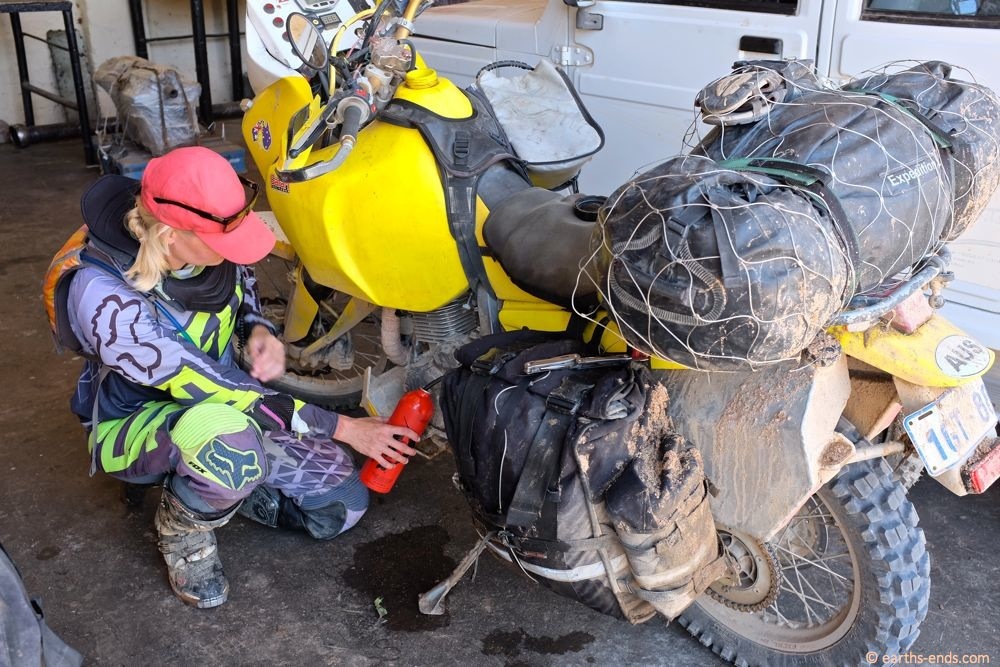
Decanting fuel from the secondary fuel tank. Only the top third flows to the carburetor under gravity. The last 6L has to be decanted manually
We headed to the Unesco World Heritage rock engravings of Twyfelfontein and found that all pretty interesting. Created by the San bushmen, they are the most significant and the largest group of rock art in Africa. They are thought to range from 2000 to 10,000 years old and were produced by people scrapping/striking away the red surface of the rocks to reveal the light coloured rock beneath. Oxidation and the dry conditions have done a lot to emphasise the petroglyphs and preserve them over time.
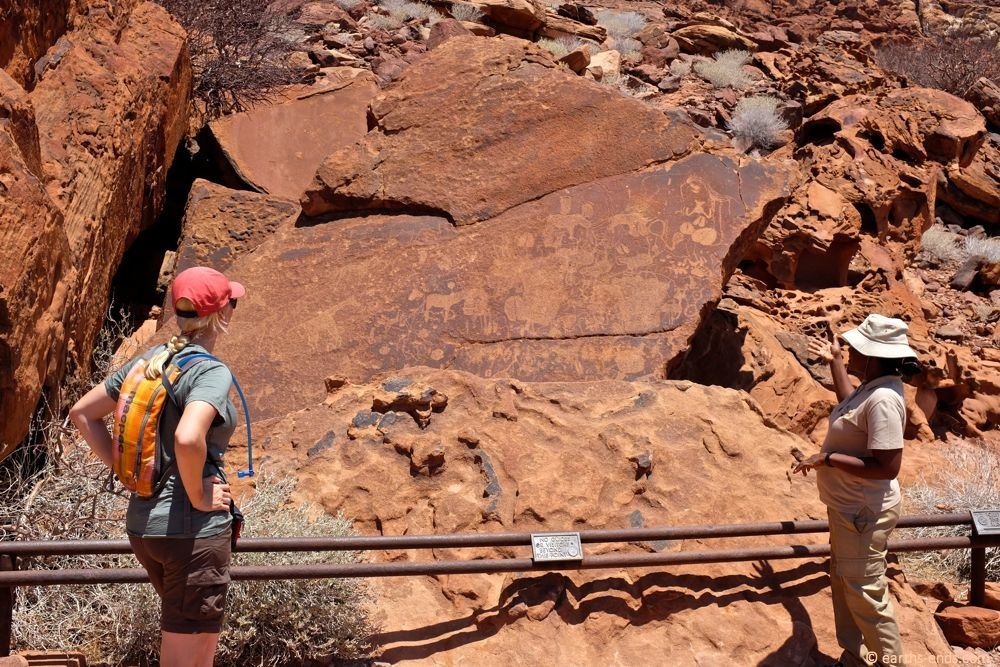
This rock is referred to as ‘the classroom’ as it depicts the various footprints and the animals they belong to. They suggest that it was used as a place to educate young San on tracking
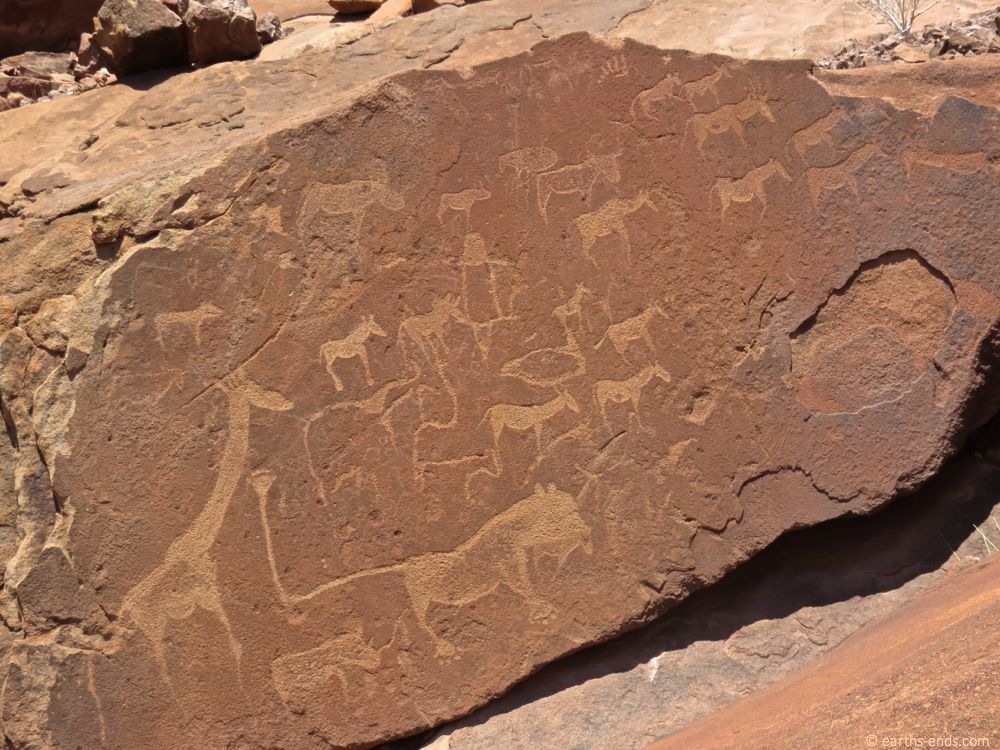
Lionman – the most famous of the petroglyphs. Look closely and you will see he has an animal in his mouth. You’ll also notice he has five digits on his toes where a lion only has four so they say this is a depiction of a shaman taking on animal form
The petroglyphs include depictions of human and animal tracks and a huge array of animals and symbols said to indicate the locations of water sources and their reliability. Very interestingly, the symbols used for permanent water source (circle with a dot in the middle) and temporary water source (circle with no dot) is the same as used by aboriginal Australians. Giraffes are a common feature of the engravings as they were a sacred animal to the San that, they were never hunted as they were seen as the harbingers of rain and could lead them to water sources.
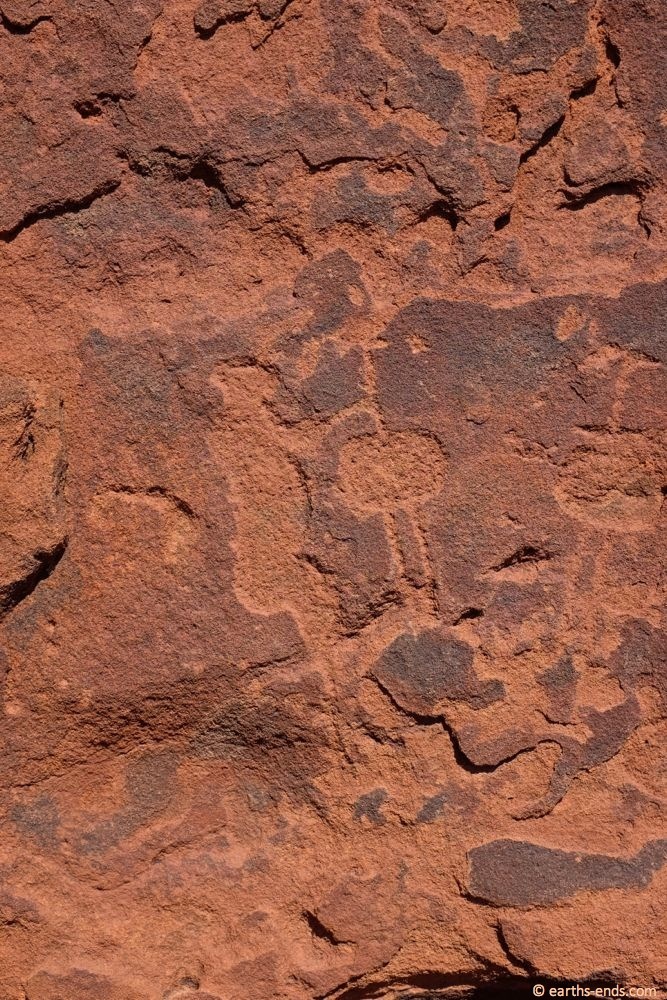
This was one of the rare depictions of humans in the engravings. He is choking an ostrich – no, that is not a euphemism for anything. He is literally choking an ostrich.
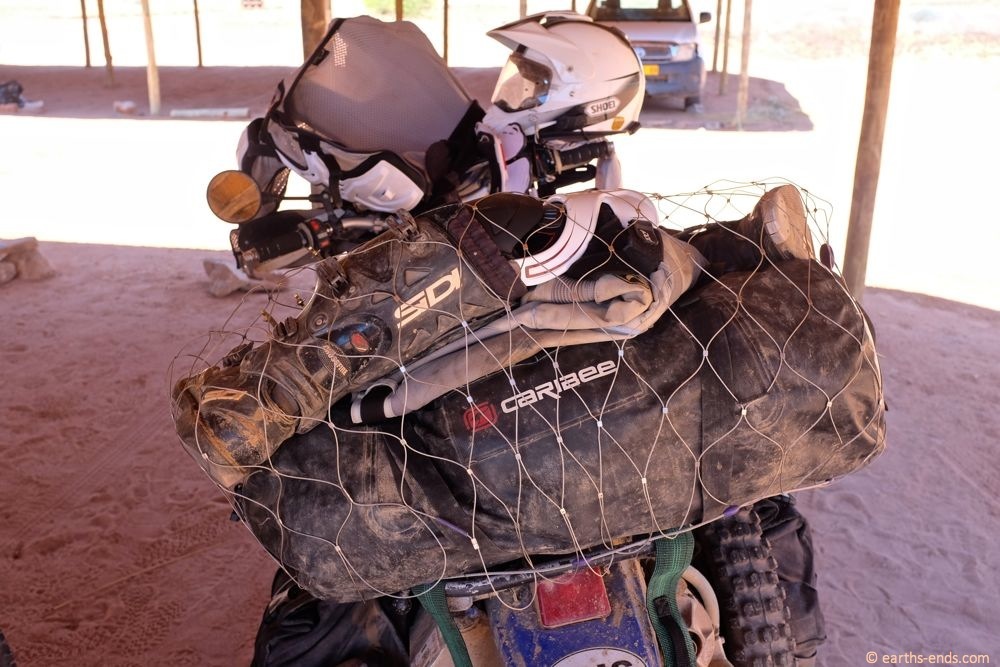
The Pacsafe security mesh bags have been a really worthwhile purchase. They serve as a great visual deterrent for thieves and can be looped through any additional tyres we might be carrying as well as both pannier bag locks. We can also expand them and shove in our body armour and boots for when we want to do some touristing in regular attire.
We checked out the nearby ‘Organ Pipes’, which is said to be one of the best examples in the world of columnar jointing with the exception of the Giant’s causeway in Ireland. I had to agree it was impressive and I couldn’t help but think all my nerdy geo mates would be green with envy over my last two days of rock fixes.

The dolerite magma penetrated the surrounding rocks parallel to the rock layering so as they cooled they formed into regularly orientated columns like the ones you see here

Mick waiting patiently to leave
Link to Video hosted on Vimeo
Leaving Twyfelfontein and crossing the Aba Huab for the 3rd time. Check out Tanya’s bike get knocked downstream a bit by the fast flowing water.
Our next stop was the Petrified Forest, which was rather mind blowing too. We arrived at closing time but the staff were nice enough to let us in to check the place out alone which provided me with considerable temptation to steal a nice sample or two. But seriously, what kind of person puts petrified wood, unsupervised, near me and expects it to sit there unmolested? A fool, that is the kind of person. A damned fool. But as it was a national monument I am proud (though slightly regretful) to say I didn’t take a thing.

In my element

This was the largest trunk we saw at 30m long
The Petrified Forest is not actually a forest but an accumulation of the petrified remnants of huge tree trunks that were uprooted and transported down ancient rivers at the end of one of Gondwana’s many ice ages about 280 million years ago. The scale of a flood that destroyed a forest of trees over 30m tall would have been of the proper eco-catastrophe kind and would be unimanginable to mere human types. A huge amount of mud and sand was also transported and covered the trunks to such an extent that they were denied the atmospheric conditions needed to decompose. Due to enormous pressure over many millions of years the tree trunks got preserved though the infiltration of silica rich fluid. The trees have been so perfectly preserved that the knots, rings, bark and grain of the wood appear exactly as they would have all that time ago as in the silicification process every single cell is the tree is exactly replaced.
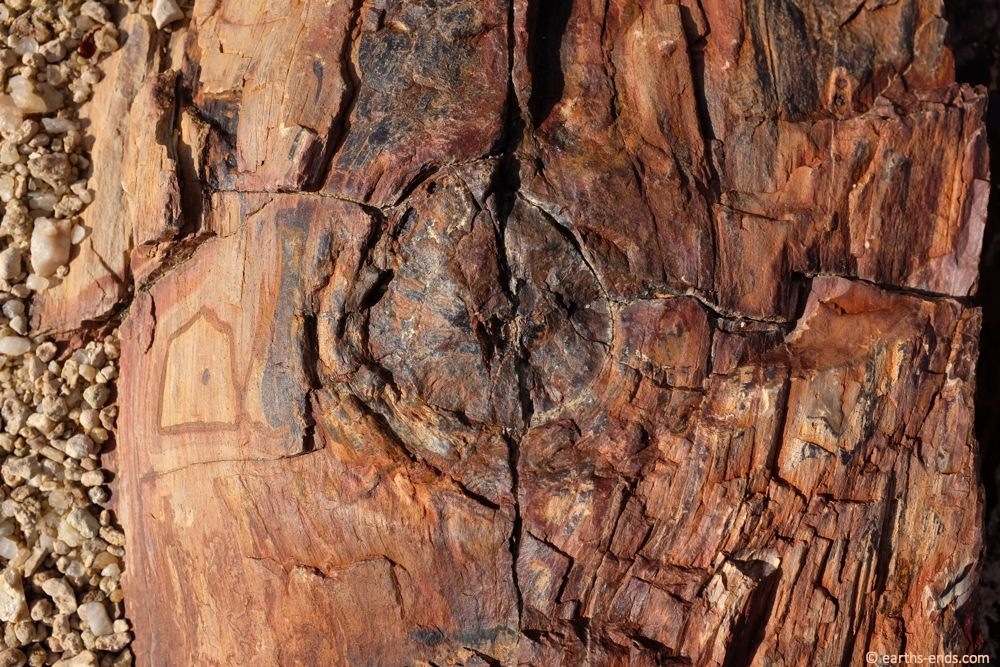
Amazing preservation
After the petrified forest we high tailed it to Palmwag where we desperately needed to get fuel, Mick estimated we would hit reserve about 30kms out which would be pushing it a bit. On our way there we spotted our first desert giraffe beside the roadside which was really exciting. The scenery as ever was fantastic and we couldn’t quite believe the variation in terrains and views we had seen just the last few days riding. With some gentle conservative riding we only went to reserve about 5kms from Palmwag and found the servo closed for the evening. So at the Palmwag Lodge we camped for a small fortune and headed to the bar and the cool, refreshing embrace of a rock shandy.
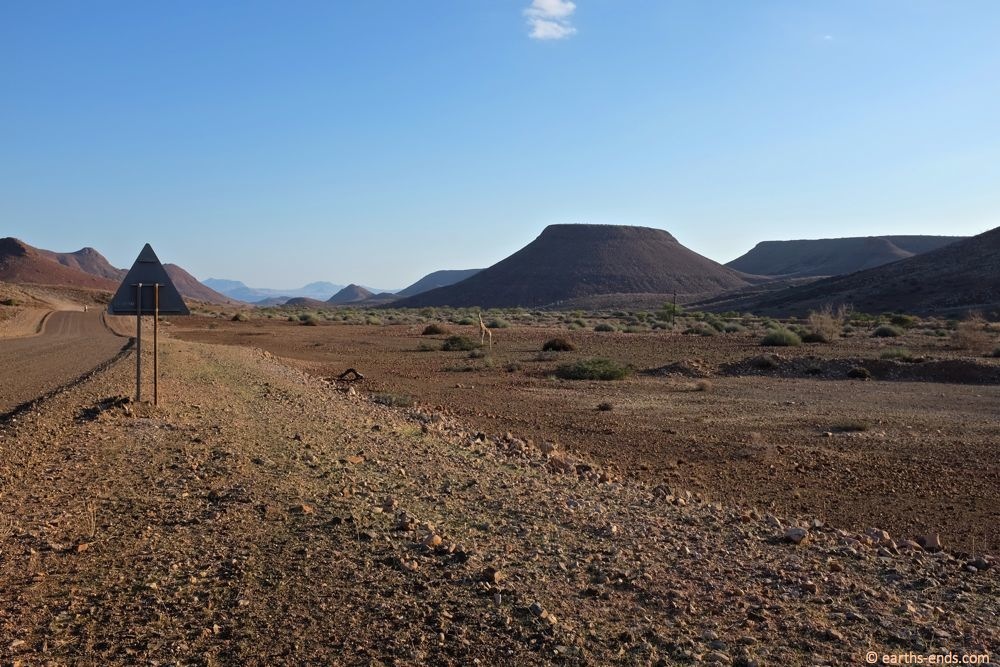
Our first desert giraffe – not to sure how they survive out here but survive they do
I don’t know I could capture the feeling as we watched the sunset over the deck. We had been near overwhelmed with the trails and scenery served up to us over the last few days. We were gloriously exhausted and contented and the real kicker was that we knew the ‘good’ stuff had only just begun. Just a little further north was Sesfontein, the gateway to Kaokoland – our anticipated highlight of our time in Namibia. All the remained was to see if it lived up to the hype and for us to survive the experience.

The main road north. Doesn’t look like it, but it is
 Earths-Ends
Earths-Ends
Keep the blog coming….lovin it. :-). We are so ready to hop back on our bikes and do ‘part 2’….till then we are soaking up your trip xxxx
Hi pam. We really enjoyed your blog and photos so will be cool when you get back on the road.
Great post – wow, spectacular rocks! I love the petroglyphs too – if you’re still interested in why the san and aboriginal waterhole symbols are the same, ask me about entoptic phenomena and links to global prehistoric art one day.
Dear Friends,
I am delighted that we provide on this trip ….. and you need a lot of determination to continue animated ……I wish everything goes as you wish …. thanks for sharing…..have a safe trip…..I will continue to accompany you……
Kind Regards.
Elsa
Dear Friends,
I am amazed at what your travel gives me …… that wonderful places ….. I wish everything goes as you wish …..
I will continue to accompany you.
Have a safe trip.
Take care of you…..
Kind regards
Elsa
I am amazed at what your travel gives me …… that wonderful places ….. I wish everything goes as you wish …..
Always great hearing from you Elsa. It is not long now until we will be using the Egypt visa that you helped us to get.
Dear Tan & Mick,
I hope that you have been well.
Back in 2016, you kindly granted Namibia Publishing House permission to use one of your images from your Namibian adventure in our Geography Grade 9 textbook. We are busy preparing a digital version of this publication and would like to reuse the image you provided us with in the same context. Acknowledgement will stay on imprint as per printed book: Tan & Mick/earths-end.com.
I hope that you will find this in order.
I look forward to hearing from you.
Warm regards,
Patrycja
hi Patrycja, yes permission grated to use in perpetuity